Kenmore 629.60002, 629.60003, 629.60008, 629.60009 Owner's Manual
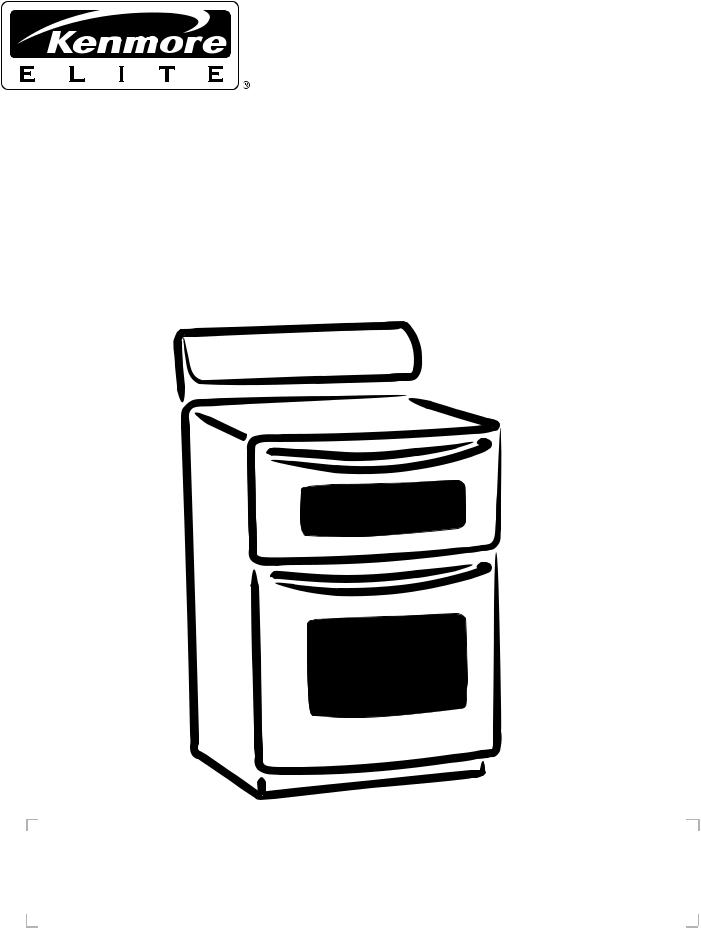
Smoothtop Double Oven Range
Use & Care Guide
Cuisinière électrique à deux fours et dessus lisse
Guía de uso y cuidado, página 30
Estufa eléctrica de cubierta lisa con doble horno
Guide d’utilisation et d’entretien, page 60
6 29.6 0002 |
6 29.6 0003 |
6 29.6 000 8 |
6 29.6 000 9 |
Part No. 81 13P708-60 |
Sears, Roebuck and Co., Hoffman Estates, IL 60179 U.S.A. |
www.sears.com |
Form No. A/01/08 |
Sears Canada, Inc., Toronto, Ontario, Canada M5B 2B8 |
Au Canada, www.sears.ca |
|
|
Litho USA |

Contents
Important Safety Instructions .................................................................................................. |
........ 2-4 |
Warranty and Protection Agreements ............................................................................................ |
5-6 |
Surface Cooking ................................................................................................................ |
................. 7-9 |
Controls |
Tips to Protect the Smoothtop Surface |
Smoothtop Surface |
Cookware Recommendations |
Warmer Zone |
Canning and Oversize Cookware |
Oven Cooking ................................................................................................................................. |
10-20 |
Control Panel |
Broiling |
Baking |
Keep Warm |
Cook & Hold |
Favorite |
Delay |
Automatic Shut-Off/Sabbath Mode |
Toasting |
Adjusting the Oven Temperature |
Proofing |
|
Care & Cleaning ............................................................................................................................. |
21-24 |
Self-Clean Ovens |
|
Cleaning Procedures |
|
Maintenance .................................................................................................................... |
......................25 |
Oven Doors |
Leveling Legs |
Oven Windows |
Convenience Outlet |
Upper and Lower Oven Lights |
|
Troubleshooting ............................................................................................................................. |
26-27 |
Guide d’utilisation et d’entretien ............................................................................................. |
..........30 |
Guía de uso y cuidado ......................................................................................................................... |
60 |
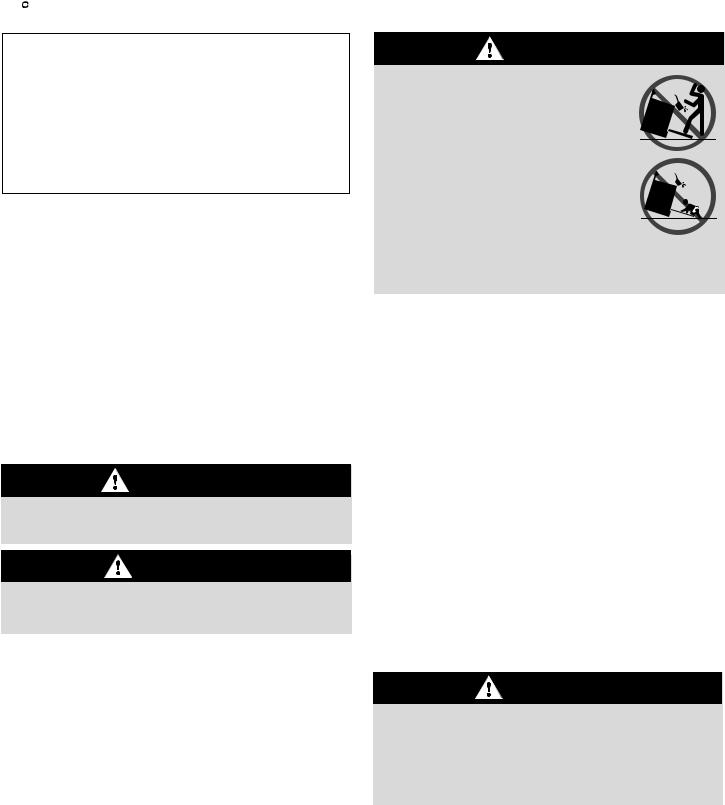
 Important Safety Instructions
Important Safety Instructions
Installer: Please leave this guide with this appliance.
Consumer: Please read and keep this Use & Care Guide for future reference, it provides the proper use and maintenance information.
In our continuing effort to improve the quality and performance of our appliances, it may be necessary to make changes to the appliance without revising this guide.
What You Need to Know About Safety Instructions
Warning and Important Safety Instructions appearing in this guide are not meant to cover all possible conditions and situations that may occur. Common sense, caution, and care must be exercised when installing, maintaining, or operating the appliance.
Always contact your dealer, distributor, service agent or manufacturer about problems or conditions you do not understand.
WARNING
• ALL RANGES CAN TIP AND
CAUSE INJURIES TO PERSONS
• INSTALL ANTI-TIP DEVICE PACKED WITH RANGE
• FOLLOW ALL INSTALLATION
INSTRUCTIONS
WARNING: To reduce risk of tipping of the appliance from abnormal usage or by excessive
loading of the oven doors, the appliance must be secured by a properly installed anti-tip device.
To check if device is properly installed, look underneath range with a flashlight to make sure one of the rear leveling legs is properly engaged in the bracket slot. The anti-tip device secures the rear leveling leg to the floor when properly engaged. You should check this anytime the range has been moved.
Recognize Safety Symbols, Words, Labels
WARNING
WARNING – Hazards or unsafe practices which COULD result in severe personal injury or death.
CAUTION
CAUTION – Hazards or unsafe practices which COULD result in minor personal injury.
Read and follow all instructions before using this appliance to prevent the potential risk of fire, electric shock, personal injury or damage to the appliance as a result of improper usage of the appliance. Use appliance only for its intended purpose as described in this guide.
General Instructions
To ensure proper and safe operation: Appliance must be properly installed and grounded by a qualified technician. Do not attempt to adjust, repair, service or replace any part of your appliance unless it is specifically recommended in this guide. All other servicing should be referred to a qualified servicer.
Always disconnect power to appliance before servicing.
In Case of Fire
Turn off appliance and ventilating hood to avoid spreading the flame. Extinguish flame then turn on hood to remove smoke and odor.
•Cooktop: Smother fire or flame in a pan with a lid or cookie sheet.
NEVER pick up or move a flaming pan.
•Ovens: Smother fire or flame by closing the oven doors.
Do not use water on grease fires. Use baking soda, a dry chemical or foam-type extinguisher to smother fire or flame.
WARNING
NEVER use an appliance as a step to reach cabinets above. Misuse of appliance doors, such as stepping, leaning or sitting on the doors, may result in possible tipping of the appliance, breakage of doors and serious injuries.
2

 Important Safety Instructions
Important Safety Instructions
If appliance is installed near a window, precautions should be taken to prevent curtains from blowing over surface elements.
NEVER use appliance to warm or heat the room. Failure to follow this instruction can lead to possible burns, injury, fire or damage to the appliance.
NEVER wear loose-fitting or hanging garments while using the appliance. Clothing could catch utensil handles or ignite and cause burns if garment comes in contact with hot heating elements.
To ensure proper operation and to avoid damage to the appliance or possible injury, do not adjust, service, repair or replace any part of the appliance unless specifically recommended in this guide. Refer all other servicing to a qualified technician.
NEVER store or use gasoline or other combustible or flammable materials in the ovens, near surface units or in the vicinity of this appliance as fumes could create a fire hazard or an explosion.
To prevent grease fires, do not let cooking grease or other flammable materials accumulate in or near the appliance.
Use only dry potholders. Moist or damp potholders on hot surfaces may result in a steam burn. Do not let potholders touch hot heating elements. Do not use a towel or other bulky cloth which could easily touch hot heating elements and ignite.
Always turn off all controls when cooking is completed.
NEVER heat unopened containers on the surface unit or in the ovens. Pressure build-up in the container may cause container to burst resulting in burns, injury or damage to the appliance.
NEVER use aluminum foil to cover oven racks or oven bottoms. This could result in risk of electric shock, fire, or damage to the appliance. Use foil only as directed in this guide.
Aerosol-type cans are EXPLOSIVE when exposed to heat and may be highly flammable. Do not use or store near appliance.
Cooktop
NEVER leave surface units unattended, especially when using high heat. An unattended boilover could cause smoking and a greasy spillover can cause a fire.
This appliance is equipped with different sized surface elements. Select pans with flat bottoms large enough to cover element. Fitting pan size to element will improve cooking efficiency.
If pan is smaller than element, a portion of the element will be exposed to direct contact and could ignite clothing or potholder.
Only certain types of glass, glass-ceramic, ceramic, earthenware or other glazed utensils are suitable for cooktop or oven service without breaking due to the sudden change in temperature. Follow utensil manufacturer s instructions when using glass.
This appliance has been tested for safe performance using conventional cookware. Do not use any devices or accessories that are not specifically recommended in this manual. Do not use stove top grills or add-on oven convection systems. The use of devices or accessories that are not expressly recommended in this manual can create serious safety hazards, result in performance problems and reduce the life of the components of this appliance.
Turn pan handle toward center of cooktop, not out into the room or over another surface element. This reduces the risk of burns, ignition of flammable materials, or spillage if pan is accidently bumped or reached by small children.
Glass-Ceramic Cooktop
NEVER cook on a broken cooktop. If cooktop should break, cleaning solutions and spillovers may penetrate the broken cooktop and create a risk of electric shock. Contact a qualified technician immediately.
Clean cooktop with caution. Some cleaners can produce noxious fumes if applied to a hot surface. If a wet sponge, cloth, or paper towel is used on a hot cooking area, be careful to avoid steam burn.
Deep Fat Fryers
Use extreme caution when moving the grease pan or disposing of hot grease. Allow grease to cool before attempting to move pan.
Ovens
Use care when opening doors. Let hot air or steam escape before removing or replacing food.
For proper oven operation and performance, do not block or obstruct oven vent duct. When ovens are in use, the vent and surrounding area near the vent may become hot enough to cause burns.
Always place oven racks in desired locations while ovens are cool. If rack must be moved while an oven is hot, do not let potholder contact hot element in oven.
3

 Important Safety Instructions
Important Safety Instructions
Self-Cleaning Ovens
CAUTION
Before self-cleaning the oven, remove the oven racks, broiler pan, food and any other utensils. Wipe spillovers to prevent excessive smoke and flare-ups.
Clean only parts listed in this guide. Do not clean door gaskets. The gaskets are essential for a good seal. Do not rub, damage, or move the gaskets.
NEVER leave children alone or unsupervised in area where appliance is in use or is still hot.
NEVER allow children to sit or stand on any part of the appliance as they could be injured or burned.
Children must be taught that the appliance and utensils in or on it can be hot. Let hot utensils cool in a safe place, out of reach of small children. Children should be taught that an appliance is not a toy. Children should not be allowed to play with controls or other parts of the unit.
Do not use oven cleaners. No commercial oven cleaner or oven liner protective coating of any kind should be used in or around any part of the ovens.
Wipe up excessive spillovers, especially greasy spills, before the clean cycle to prevent smoking, flare-ups or flaming.
It is normal for the cooktop to become hot during a clean cycle. Therefore, avoid touching the cooktop, door, window or oven vent during a clean cycle.
Heating Elements
NEVER touch surface or oven heating elements, areas near elements, or interior surfaces of ovens.
Heating elements may be hot even though they are dark in color. Areas near surface elements and interior surfaces of the ovens may become hot enough to cause burns. During and after use, do not touch or let clothing or other flammable materials contact heating elements, areas near elements or interior surfaces of ovens until they have had sufficient time to cool.
Other potentially hot surfaces include: Cooktop, areas facing the cooktop, oven vent, and surfaces near the vent opening, oven doors, areas around the doors and oven windows.
Child Safety
CAUTION
NEVER store items of interest to children in cabinets above an appliance. Children climbing on the appliance or on the appliance doors to reach items could be seriously injured.
Ventilating Hoods
Clean range hood and filters frequently to prevent grease or other flammable materials from accumulating on hood or filter and to avoid grease fires.
Turn the fan on when flambéing foods (such as Cherries Jubilee) under the hood.
Important Safety Notice and Warning
The California Safe Drinking Water and Toxic Enforcement Act of 1986 (Proposition 65) requires the Governor of California to publish a list of substances known to the State of California to cause cancer or reproductive harm, and requires businesses to warn customers of potential exposures to such substances.
Users of this appliance are hereby warned that when the oven is engaged in the self-clean cycle, there may be some low-level exposure to some of the listed substances, including carbon monoxide. Exposure to these substances can be minimized by properly venting the oven to the outdoors by opening the windows and/or door in the room where the appliance is located during the self-clean cycle.
IMPORTANT NOTICE REGARDING PET BIRDS: Never keep pet birds in the kitchen or in rooms where the fumes from the kitchen could reach. Birds have a very sensitive respiratory system. Fumes released during an oven self-cleaning cycle may be harmful or fatal to birds. Fumes released due to overheated cooking oil, fat, margarine and overheated non-stick cookware may be equally harmful.
Save These Instructions for Future Reference
4
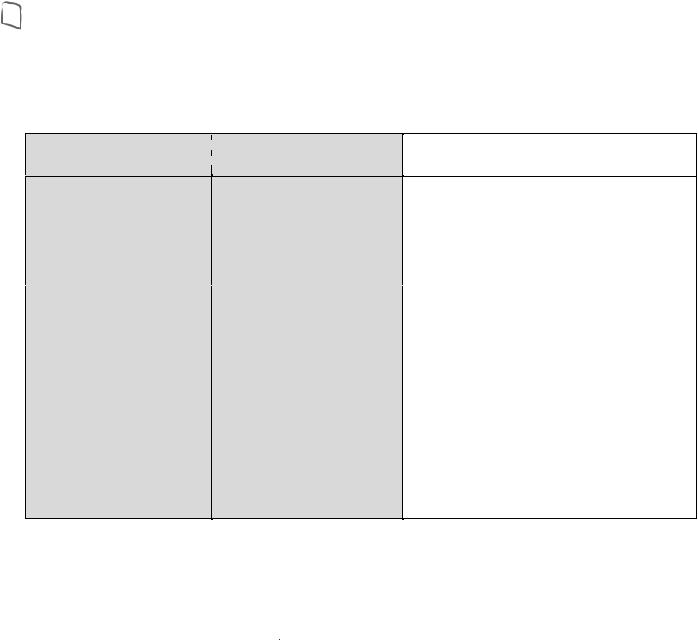
 Warranty & Service
Warranty & Service
KENMORE ELECTRIC RANGE
Free-Standing Model
What Sears will do, in case of defect:
Sears Canada Inc., warrants every Kenmore Range to be free from defects in material or workmanship, as follows:
LENGTH OF |
COVERED BY |
NOT COVERED BY |
WARRANTY: |
WARRANTY: |
WARRANTY: |
|
|
|
|
|
|
|
|
|
|
|
|
|
|
|
|
|
|
|
|
|
|
|
|
|
|
|
|
|
|
ONE YEAR FULL |
|
|
Replacement parts and repair |
|
|
|||||||||||||||||||
|
|
|
|
|
|
|
|
|
|
|
|
|
|
|
|
||||||||||
|
|
|
|
|
|
|
|
|
|
|
|
|
|
|
|
|
|
|
|
|
|
|
|
||
|
|
|
|
WARRANTY |
|
labor costs to correct defects |
|
|
|
||||||||||||||||
|
|
|
|
|
|
|
|
|
|
|
|
|
|
|
|
|
|
|
|
|
|
||||
|
|
|
|
FROM DATE |
|
in materials or workmanship. |
|
|
|
||||||||||||||||
|
|
|
|
|
|
|
|
|
|
|
|
|
|
|
|||||||||||
|
|
|
|
|
|
|
|
|
|
|
|
|
|
|
|
|
|
||||||||
|
|
|
OF PURCHASE |
Service mustbe provided by |
|
|
|
|
|
||||||||||||||||
|
|
|
|
|
|
|
|
|
|
|
|
|
|
|
|
||||||||||
|
|
|
|
|
|
|
|
|
|
|
|
|
|
|
|
|
|
|
|
|
|
||||
|
|
|
|
|
|
|
|
|
|
|
|
|
|
|
anauthorized servicing outlet. |
||||||||||
|
|
|
|
|
|
|
|
|
|
|
|
|
|
||||||||||||
|
|
|
|
|
|
|
|
|
|
|
|
|
|
|
|
|
|
|
|
|
|
|
|
|
|
|
2ND THROUGH |
|
Replacement parts for ceramic |
|
|||||||||||||||||||||
|
|
|
|
|
|
|
|
||||||||||||||||||
|
|
|
|
|
|
|
|
|
|
|
|
|
|
|
|||||||||||
|
|
|
|
|
5TH YEAR |
|
glass cooktop if breakage is |
|
|
||||||||||||||||
|
|
|
|
|
|
|
|
|
|
|
|
|
|
|
|
||||||||||
|
|
|
|
|
|
|
|
|
|
|
|
|
|||||||||||||
|
|
|
|
|
|
LIMITED |
|
due to defects in material or |
|
||||||||||||||||
|
|
|
|
|
|
|
|
||||||||||||||||||
|
|
|
|
WARRANTY |
workmanship. |
|
|||||||||||||||||||
|
|
|
|
|
|
|
|
|
|
|
|
|
|
||||||||||||
|
|
|
|
|
|
|
|
|
|
|
|
|
|
|
|
|
|
|
|
|
|
|
|
|
|
A.Service calls to:
1.Correct the installation of the range.
2.Instruct you how to use the range.
3.Replace house fuses or correct house wiring.
B.Repairs when range is used in other than normal home use.
C.Damage resulting from accident, alteration, misuse, abuse, improper installation or installation not in accordance with local electrical codes.
D.Any labor costs during the limited warranties.
E.Replacement parts or repair labor costs forunits operated outside Canada.
F.Pickup and delivery. This product is designed tobe repaired in the home.
G.Repairs to parts or systems caused by unauthorized modifications made to the appliance.
This warranty applies only to Kenmore Range purchased at Sears Canada Inc., and which are owned and operated inCanada for household use only.
This warranty is in addition to any statutory warranty.
If any service is required under this warranty,
call the toll free number (English) 1-800-4MY HOME® or call the toll free number (French) 1-800-LE-FOYERMC
Protect your appliance even after your warranty expires:
ask about Sears Maintenance Agreement which will cover you for workmanship not included in your warranty.
SEARS CANADA INC. Toronto, Canada M5B 2B8
5

 Protection Agreements
Protection Agreements
In the USA
Master Protection Agreements
Congratulations on making a smart purchase. Your new Kenmore® product is designed and manufactured for years of dependable operation. But like all products, it may require preventive maintenance or repair from time to time. That s when having a Master Protection Agreement can save you money and aggravation.
Purchase a Master Protection Agreement now and protect yourself from unexpected hassle and expense.
The Master Protection Agreement also helps extend the life of your new product. Here s what s included in the Agreement:
Expert service by our 12,000 professional repair specialists
Unlimited service and no charge for parts and labor on all covered repairs
“No-lemon” guarantee – replacement of your covered product if four or more product failures occur within twelve months
Product replacement if your covered product can t be fixed
Annual Preventive Maintenance Check at your request no extra charge
Fast help by phone – phone support from a Sears technician on products requiring in-home repair, plus convenient repair scheduling
Power surge protection against electrical damage due to power fluctuations
Rental reimbursement if repair of your covered product takes longer than promised
Once you purchase the Agreement, a simple phone call is all that it takes for you to schedule service. You can call anytime day or night, or schedule a service appointment online.
Sears has over 12,000 professional repair specialists, who have access to over 4.5 million quality parts and accessories. That s the kind of professionalism you can
count on to help prolong the life of your new purchase for years to come. Purchase your Master Protection Agreement today!
Some limitations and exclusions apply. For prices and additional information, call 1-800-827-6655.
Sears Installation Service
For Sears professional installation of home appliances, garage door openers, water heaters, and other major home items, in the USA call 1-800-4-MY-HOME® (1-800-469-4663).
In Canada
Maintenance Agreements
Your purchase has added value because you can depend on Sears HomeCentral ® for service. With over 2,400 Service Technicians and more than a million parts and accessories, we have the tools, parts, knowledge and skills to back our pledge: We Service What We Sell.
Your Kenmore® product is designed, manufactured and tested to provide years of dependable operation. But like all products, it may require service from time to time. The Sears Maintenance Agreement offers you an outstanding service program, affordably priced.
Sears Maintenance Agreement
Is your way to buy tomorrow s service at today s price
•Eliminates repair bills resulting from normal wear and tear
Provides phone support from a Sears technician on products requiring in-home repair
Even if you don t need repairs, provides an annual Preventive Maintenance Check, at your request, to ensure that your product is in proper running condition
Some limitations apply. For information about Sears Canada Maintenance Agreements, call 1-800-361-6665.
6
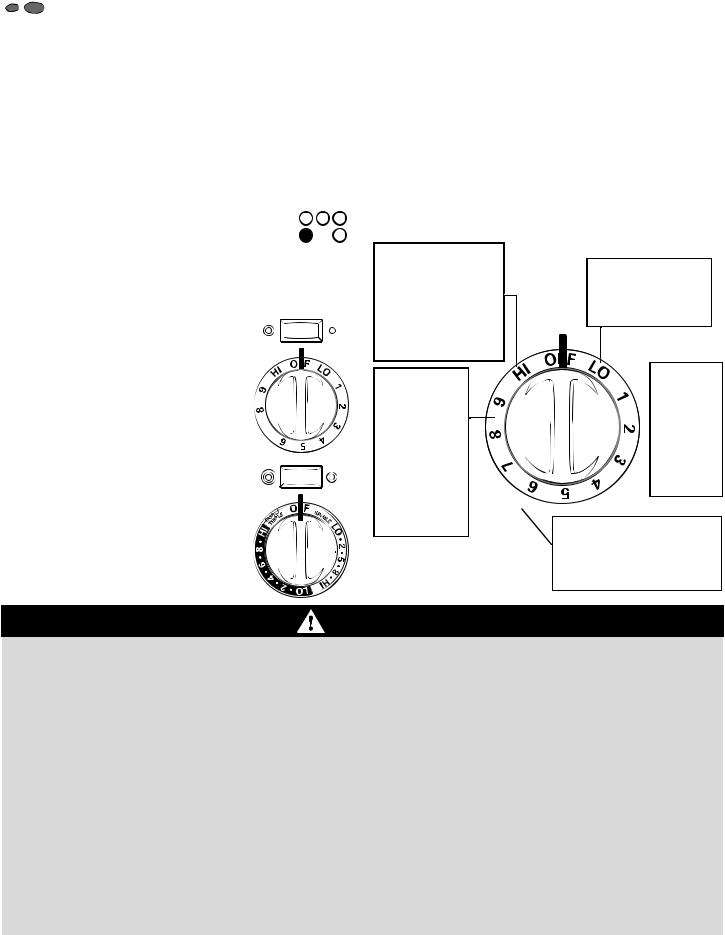
 Surface Cooking
Surface Cooking
Surface Controls
Use to turn on the surface elements. An infinite choice of heat settings is available from LO to HI. The knobs can be set on or between any of the settings.
Setting the Controls
1.Place pan on surface element.
2.Push in and turn the knob in either direction to the desired heat setting.
The control panel is marked to identify which element the knob controls. For example, the graphic at right indicates left front element.
3.There is an element ON indicator light on the control panel. When any surface control knob is turned on, the light will turn on. The light will turn off when all the surface elements are turned off.
4. After cooking, turn knob to OFF Remove pan.
Dual/Triple Element
The cooking surface has a dual element located in the left front of the smoothtop.
This allows you to change the size of these  elements. Press the switch to the left to use
elements. Press the switch to the left to use the large element or to the right to use the
the large element or to the right to use the
small element.
The cooking surface has one triple element located in the right front position. This element can be used for larger cooking utensils when the triple element is used, or for smaller pans when the single or dual settings are chosen.
To operate the single element only, use the right side of the control knob and select any setting from LO to HI.
To operate the dual or triple elements, press the switch above the knob to the left for the triple element or to the right for the double element. Then, use the left side of the control knob to select any heat setting from LO to HI.
Suggested Heat Settings
The size, type of cookware and cooking operation will affect the heat setting. For information on cookware and other factors affecting heat settings, refer to Cookware Recommendations on page 9.
HI: Use to bring liquid to a boil. Always reduce setting to a lower heat when liquids begin to boil or foods begin to cook.
Med. High (8-9): Use to brown meat, heat oil for deep fat frying or sauteing. Maintain fast boil for large amounts of liquids.
LO (2): Use to keep foods warm and melt chocolate and butter.
Med. Low
(3-4): Use to continue cooking covered foods or steam 
 foods.
foods.
Medium (5-7): Use to maintain slow boil for large amounts of liquids and for most frying operations.
CAUTION
BEFORE COOKING
Always place a pan on the surface unit before you turn it on. To prevent damage to range, never operate surface unit without a pan in place.
NEVER use the cooktop as a storage area for food or cookware.
DURING COOKING
Be sure you know which knob controls which surface unit. Make sure you turned on the correct surface unit.
Begin cooking on a higher heat setting then reduce to a lower setting to complete the operation. Never use a high heat setting for extended cooking.
NEVER allow a pan to boil dry. This could damage the pan and the appliance.
•NEVER touch cooktop until it has cooled. Expect some parts of the cooktop, especially around the surface units, to become warm or hot during cooking. Use potholders to protect hands.
AFTER COOKING
•Make sure surface unit is turned off.
•Clean up messy spills as soon as possible.
OTHER TIPS
If cabinet storage is provided directly above cooking surface, limit it to items that are infrequently used and can be safely stored in an area subjected to heat. Temperatures may be unsafe for items such as volatile liquids, cleaners or aerosol sprays.
NEVER leave any items, especially plastic items, on the cooktop. The hot air from the vent may ignite flammable items, melt or soften plastics, or increase pressure in closed containers causing them to burst.
NEVER allow aluminum foil, meat probes or any other metal object, other than a pan on a surface element, to contact heating elements.
•NEVER store heavy items above the cooktop that could fall and damage it.
7
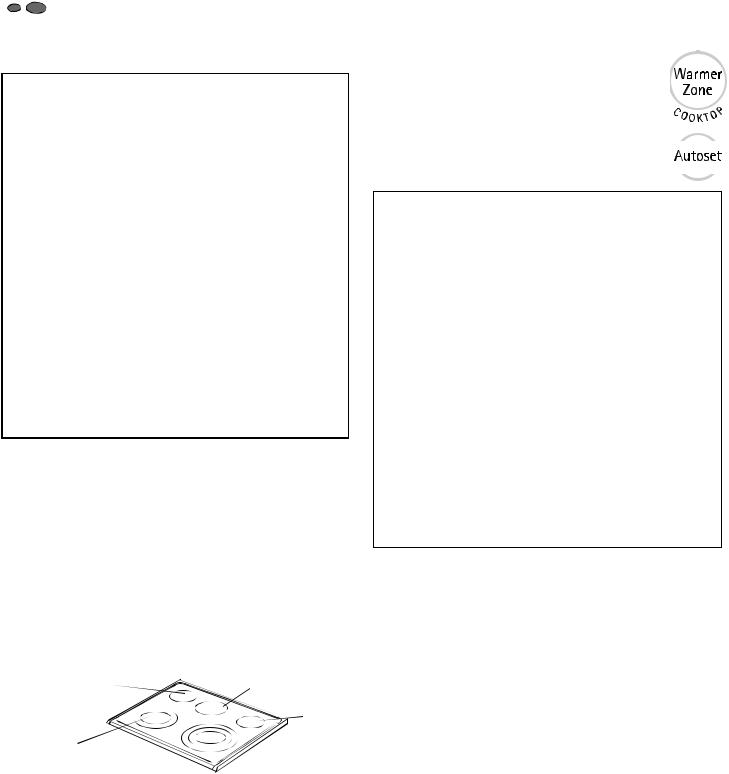
 Surface Cooking
Surface Cooking
Smoothtop Surface
Notes:
On Canadian models, the smoothtop does NOT operate during a clean cycle.
Cooktop may emit light smoke and odor the first few times the cooktop is used. This is normal.
Smoothtop cooktops retain heat for a period of time after the element is turned off. Turn the elements off a few minutes before food is completely cooked and use the retained heat to complete cooking. When the Hot Surface Indicator light turns off, the cooking area will be cool enough to touch. Because of the way they retain heat, the smoothtop elements will not respond to changes in settings as quickly as coil elements.
In the event of a potential boilover, remove the pan from the cooking surface.
Never attempt to lift the cooktop.
The smoothtop surface may appear discolored when it is hot. This is normal and will disappear when the surface cools.
Cooking Areas
The cooking areas on your range are identified by permanent circles on the smoothtop surface. For most efficient cooking, fit the pan size to the element size.
Pans should not extend more than 1/ 2 to 1-inch beyond the cooking area.
2 to 1-inch beyond the cooking area.
When a control is turned on, a glow can be seen through the smoothtop surface. The element will cycle on and off to maintain the preset heat setting, even on HI.
For more information on cookware, refer to Cookware Recommendations on page 9.
SINGLE WARMER ZONE
ELEMENT
SINGLE
ELEMENT
DUAL
ELEMENT
TRIPLE
ELEMENT
Hot Surface Indicator Light
The Hot Surface indicator light is located on the control panel. The light will be illuminated when any cooking area is hot. It will remain on, even after the control is turned off, until the area has cooled.
Warmer Zone (style may vary by model)
Use the Warmer Zone to keep hot cooked foods warm, such as vegetables, gravies and oven-safe dinner plates.
Setting the Control:
Touch the Warmer Zone pad and then
the Autoset pad. Press Autoset pad again to turn off.
Notes:
Never warm food for longer than one hour (eggs for 30 minutes), as food quality may deteriorate.
Do not heat cold food on the Warmer Zone.
Warming temperatures of the food will vary depending on type and amount of food. Always hold food at proper food temperatures. USDA recommends food temperatures between 140 -170 F.
Use only cookware recommended as safe for oven and cooktop use.
Always use oven mitts when removing food from the Warmer Zone as cookware will be hot.
All foods should be covered with a lid or aluminum foil to maintain food quality.
When warming pastries and breads the cover should have an opening to allow moisture to escape.
Do not use plastic wrap to cover foods. Plastic may melt on to the surface and be very difficult to clean.
Tips to Protect the
Smoothtop Surface
Cleaning (see page 23 for more information) Before first use, clean the cooktop.
Clean your cooktop daily or after each use. This will keep your cooktop looking good and can prevent damage.
•If a spillover occurs while cooking, immediately clean the spill from the cooking area while it is hot to prevent a tough cleaning chore later. Using extreme care, wipe spill with a clean dry towel.
•Do not allow spills to remain on the cooking area or the cooktop trim for a long period of time.
Never use abrasive cleansing powders or scouring pads which will scratch the cooktop.
•Never use chlorine bleach, ammonia or other cleansers not specifically recommended for use on glass-ceramic.
8
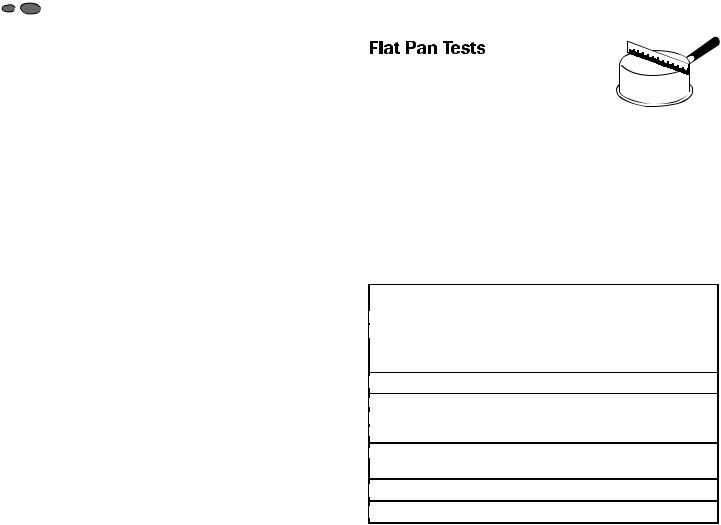
 Surface Cooking
Surface Cooking
To Prevent Marks & Scratches
•Do not use glass pans. They may scratch the surface.
Never place a trivet or wok ring between the surface and pan. These items can mark or etch the top.
Do not slide aluminum pans across a hot surface. The pans may leave marks which need to be removed promptly. (See Cleaning, page 23.)
Make sure the surface and the pan bottom are clean before turning on to prevent scratches.
•To prevent scratching or damage to the glass-ceramic top, do not leave sugar, salt or fats on the cooking area. Wipe the cooktop surface with a clean cloth or paper towel before using.
•Never slide heavy metal pans across the surface since these may scratch.
To Prevent Stains
•Never use a soiled dish cloth or sponge to clean the cooktop surface. A film will remain which may cause stains on the cooking surface after the area is heated.
Continuously cooking on a soiled surface may/will result in a permanent stain.
To Prevent Other Damage
Do not allow plastic, sugar or foods with high sugar content to melt onto the hot cooktop. Should this happen, clean immediately. (See Cleaning, page 23.)
Never let a pan boil dry as this will damage the surface and pan.
•Never use cooktop as a work surface or cutting board.
•Never cook food directly on the surface.
Do not use a small pan on a large element. Not only does this waste energy, but it can also result in spillovers burning onto the cooking area which requires extra cleaning.
•Do not use non-flat specialty items that are oversized or uneven such as round bottom woks, rippled bottom and/or oversized canners and griddles.
•Do not use foil or foil-type containers. Foil may melt onto the glass. If metal melts on the cooktop, do not use. Call an authorized Servicer.
Cookware Recommendations
Using the right cookware can prevent many problems, such as food taking longer to cook or achieving inconsistent results. Proper pans will reduce cooking times, use less energy, and cook food more evenly.
See if your pans are flat.
The Ruler Test:
1.Place a ruler across the bottom of the pan.
2.Hold it up to the light.
3.Little or no light should be visible under the ruler.
The Bubble Test:
1.Put 1 inch of water in the pan. Place on cooktop and turn control to HI
2.Watch the formation of the bubbles as the water heats. Uniform bubbles mean good performance, and uneven bubbles indicate hot spots and uneven cooking.
|
Select |
Avoid |
|
|
|
|
Flat, smooth-bottom |
Pans with grooved or warped bottoms. |
|
||
|
pans. |
Pans with uneven bottoms do not cook |
|
||
|
|
efficiently and sometimes may not |
|
|
boil liquid. |
|
Heavy-gauge pans. |
Very thin-gauge metal or glass pans. |
|
||
|
Pans that are the |
Pans smaller or larger than the |
|
||
|
same size as the |
element by 1 inch. |
|
||
|
element. |
|
|
|
|
|
Secure handles. |
Cookware with loose or broken handles. |
|
||
|
|
Heavy handles that tilt the pan. |
|
Tight-fitting lids. |
Loose-fitting lids. |
|
||
|
Flat bottom woks. |
Woks with a ring-stand bottom. |
|
Canning and Oversize Cookware
All canners and large pots must have flat bottoms and must be made from heavy-gauge materials. This is critical on smoothtop surfaces. The base must not be more than
1 inch larger than the element.
When canners and pots do not meet these standards, cooking times may be longer, and cooktops may be damaged.
Some canners are designed with smaller bases for use on smoothtop surfaces.
When canning, use the HI heat setting only until the water comes to a boil or pressure is reached in the canner. Reduce to the lowest heat setting that maintains the boil or pressure. If the heat is not turned down, the cooktop may be damaged.
9
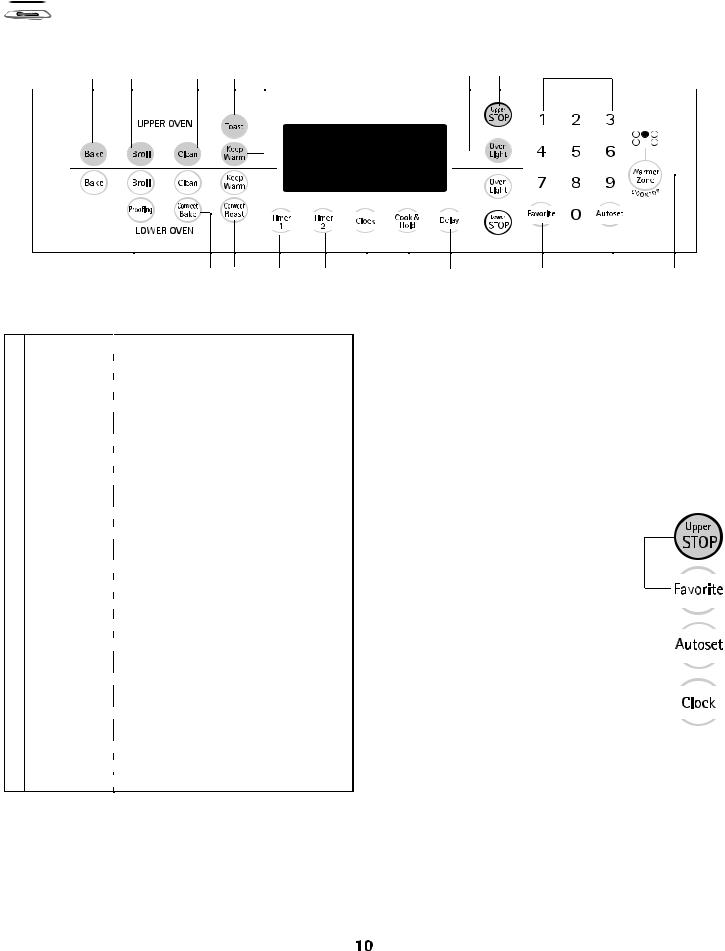
 Oven Cooking
Oven Cooking
Control Panel
A B C D E F G H
I J K L M N O P Q R
The control panel is designed for ease in programming. The display window on the control shows time of day, timer and oven functions. Control panel shown includes model specific features. (Styling may vary depending on model.)
A |
|
|
Bake |
|
Use for baking and roasting. |
||||
|
B |
||||||||
|
|
|
Broil |
|
Use for broiling and top browning. |
||||
|
|
|
|
||||||
|
C |
|
|
Clean |
|
Use to set self-clean cycle. |
|||
|
|
|
|
||||||
|
D |
|
|
Toast |
|
Use for toasting bread and products |
|||
|
|
|
|
||||||
|
E |
|
|
|
|
|
toasted in toaster or toaster oven. |
||
|
|
|
|
Keep Warm |
|
Use to keep cooked food warm in oven. |
|||
|
|
|
|
|
|||||
|
F |
|
|
|
Oven Light |
|
Use to turn the oven lights on or off. |
||
|
|
|
|
|
|||||
|
G |
|
|
STOP |
|
Cancels all operations except timer, |
|||
|
|
|
|
||||||
|
H |
|
|
|
|
clock and Surface Warming Center. |
|||
|
|
|
Number Pads |
|
Use to set time and temperature. |
||||
|
|
||||||||
|
I |
|
|
|
|
|
Proofing |
|
Use to raise yeast-based bread |
|
|
|
|
|
|
|
|||
|
J |
|
|
|
|
|
|
products prior to baking. |
|
|
|
|
|
|
Convect Bake |
|
Use for convection baking. |
||
|
|
|
|
|
|
||||
|
K |
|
|
Convect Roast |
|
Use for convection roasting. |
|||
|
|
|
|
||||||
|
L |
|
|
|
Timer 1 or 2 |
|
Sets the timer. |
||
|
|
|
|
|
|||||
|
M |
Clock |
|
Use to set time-of-day clock. |
|||||
|
|
||||||||
|
N |
|
|
Cook & Hold |
|
Bakes for a preset time, then keeps food |
|||
|
|
|
|
||||||
|
O |
|
|
|
|
warm for 1 hour. |
|||
|
|
|
Delay |
|
Programs the oven to start baking or |
||||
|
|
|
|
||||||
|
P |
|
|
|
|
cleaning at a later time. |
|||
|
|
|
Favorite |
|
Use to set and save a specific Cook & Hold |
||||
|
|
|
|
||||||
|
Q |
|
|
|
procedure. |
||||
|
|
Autoset |
|
Use to quickly set temperatures. |
|||||
|
|
|
|||||||
|
R |
|
Cooktop |
|
Use to keep foods warm on the cooktop |
||||
|
|
|
|||||||
|
|
|
|
|
|
|
Warmer Zone |
|
for serving. |
|
|
|
|
|
|
|
|
||
|
|
|
|
|
|
|
|
|
|
Using the Touchpads
Press the desired pad.
Press the number pads to enter time or temperature.
Or, press the Autoset pad to enter temperature.
A beep will sound when any pad is touched.
A double beep will sound if a programming error occurs.
Important: Four seconds after entering the time or temperature, it will automatically be entered. If more than 30 seconds elapse between touching a function pad and the number pads, the function will be canceled and the display will return to the previous display.
Clock
The clock can be set to display time in a 12-hour or 24-hour format. The clock is set at the factory for the 12-hour format.
To change the clock to 24-hour format:
1. Press and hold the Upper STOP pad and Favorite pad for three (3) seconds.
12 Hr flashes in the display.
2.Press the Autoset pad to select 24 Hr; press again to select 12 Hr.
3.Set the time of day following the directions in the To set the Clock section.
To set the Clock:
1. Press the Clock pad.
The time of day flashes in the display.
Colon flashes in the display.
2.Press the appropriate number pads to set the time of day.
3.Press the Clock pad again or wait four (4) seconds.
The colon will remain on.
When electrical power is supplied or after a power interruption, the last clock time before power was interrupted will flash.
To recall the time of day when another time function is showing, press the Clock pad.
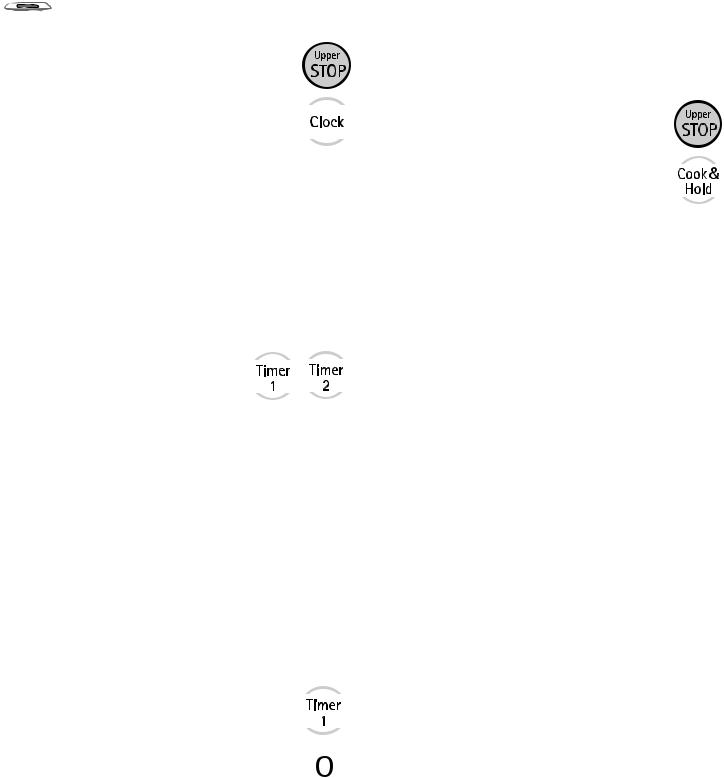
 Oven Cooking
Oven Cooking
To cancel the Clock display:
If you do not want the time of day to display:
Press and hold the Upper STOP and Clock pads for three seconds. The time of day will disappear from the display.
When the clock display is canceled, press the
Clock pad to briefly display the time of day.
To restore the Clock display:
Press and hold the Upper STOP and Clock pads for three (3) seconds. The time of day will reappear in the display.
Timer
Each timer can be set from one minute (00:01) up to 99 hours and 59 seconds (99:59).
The timers can be used independently of any other oven activity. They can also be set while another oven function is operating.
The Timers do not control the oven.
To set the Timer 1 or 2:
1. Press the Timer 1 or 2 pad.
00:00 and TIMER 1 or 2 flash in the display.
2.Press the appropriate number pads until the correct time appears in the display.
The colon and TIMER 1 or 2 will continue to flash.
TIMER 1 or TIMER 2 will be displayed. If both timers are active, TIMER 1 and TIMER 2 will be displayed.
3. Press Timer pad again or wait four seconds.
The colon stops flashing and the time begins counting down.
The last minute of the timer countdown will be displayed in seconds.
4.At the end of the set time, one long beep will sound and End will be displayed.
5.Press the Timer pad to clear the display.
To cancel the Timer:
1.Press and hold the corresponding Timer pad for three (3) seconds.
OR
2. Press the Timer pad and press 0 using the number pads.
Locking the Control and Oven Doors
The touchpad and oven doors can be locked for safety, cleaning, or to prevent unwanted use. The touchpads will not function when locked.
If an oven is currently in use, the touchpads and doors cannot be locked.
The current time of day will remain in the display when the touchpads and doors are locked.
To lock both doors:
1. Press and release STOP pad.
2.Press and hold the Upper STOP and Cook & Hold pads for three (3) seconds.
OFF appears in the display
LOCK flashes while the doors are locking.
Both oven doors lock. LOCK remains in the display.
To unlock both doors:
Press and hold the Upper STOP and Cook & Hold pads for three (3) seconds. OFF disappears from the display and LOCK flashes while the doors are unlocking.
Important: The touchpads and oven doors cannot be locked if the oven temperature is 400 F or above.
Fault Codes
BAKE or LOCK may flash rapidly in the display to alert you if there is an error or a problem. If BAKE or LOCK flash in the display, press STOP pad. If BAKE or LOCK continue to flash, disconnect power to the appliance. Wait a few minutes, and then reconnect power. If the flashing still continues, disconnect power to the appliance and call an authorized servicer.
Adjusting Sound Level
The factory default setting for sound is medium (MEd), but it can be changed to low (LO) or high (HI). To change the setting:
1. Press and hold Delay and Upper STOP pads for three (3) seconds. A beep will sound. bEEP and the current sound level ( LO MEd or HI ) will appear in the display.
2.Press the Autoset pad to increase or decrease the sound level.
3.Wait four (4) seconds and the new setting will be accepted.
4.If the Autoset pad is not pressed within 30 seconds, the control will return to the existing setting.
Changing Temp F/ C
The factory default setting for temperature is Fahrenheit. To change the setting:
1.Press and hold the upper oven Bake and STOP pads for three (3) seconds. A beep will sound and the current setting ( F or C) will appear in the display.
2.Press the Autoset pad to change the setting between F and °C.
11
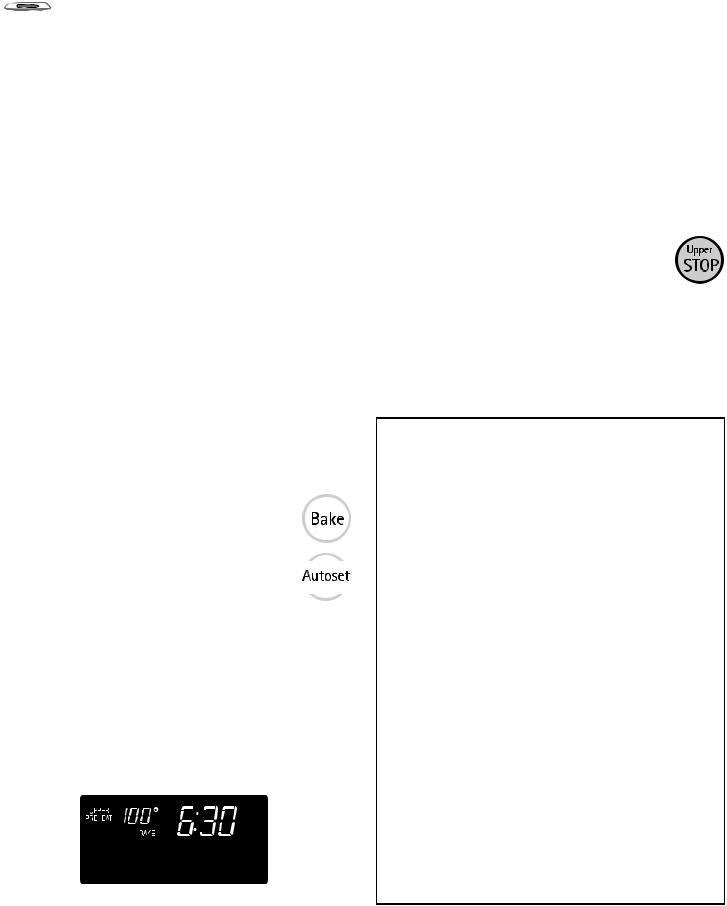
 Oven Cooking
Oven Cooking
3.Wait four (4) seconds and the new setting will be accepted.
4.If the Autoset pad is not pressed within 30 seconds, the control will return to the existing setting.
Return To Factory Default
Settings
The control can be reset to the factory default settings. To return to the default settings:
1.Press and hold upper oven Keep Warm and STOP pads for three (3) seconds. A single beep will sound and 12:00 will appear in the display.
2.Reset the clock to the current time of day.
Setting Oven Functions
Autoset Pad
Use with function pads to automatically set:
350 F bake temperature
HI or LO broil
three hours of cleaning time
four minutes of toasting time
170 F keep warm temperature
Baking
To set Bake:
1.Press the Bake pad for desired oven. BAKE and 000 will flash in the display.
2.Select the oven temperature. Press the Autoset pad for 350 F or the appropriate number pads.
Each additional press of the Autoset pad will increase the temperature by 25
The oven temperature can be set from 170 to 550
3. Press Bake pad again or wait four (4) seconds.
BAKE will stop flashing and light in the display.
PREHEAT will light in the display.
100 or the actual oven temperature if over 100 F will display. It will rise in 5 increments until the preset temperature is reached.
4.Allow 4-10 minutes for the upper oven to preheat and 7-12 minutes for the lower oven to preheat.
When the set oven temperature is reached, one long beep will sound.
The set temperature will display.
PREHEAT will turn off.
To recall set temperature during preheat, press Bake pad.
5.Place food in the oven.
6.Check cooking progress at the minimum cooking time. Cook longer if needed.
7. When cooking is finished, press the appropriate STOP pad.
8. Remove food from the oven.
Baking Differences Between Your Old and New Oven
It is normal to notice some baking time differences between a new oven and an old one. See Adjusting the Oven Temperature on page 18.
Notes:
If the lower oven is NOT in use, the upper oven will preheat more quickly.
Allow at least /2 -inch between the baking pan or casserole and the top element in the upper oven.
Loaf, angel food or bundt pans are not recommended in the upper oven.
For food safety reasons, lower temperatures are not recommended. Do not use temperatures below 140 F to keep food warm or below 200 F for cooking.
The back part of the lower oven bake element will not glow red during baking. This is normal.
When baking frozen, self-rise pizza in the upper oven, place the pizza on a cookie sheet to avoid overbrowning.
When preheating with a baking/pizza stone inside the upper oven, do not set oven above 400 F. To use baking/ pizza stones at temperatures above 400 in the upper oven, put stone in after the preheat beep.
To change the oven temperature during cooking, press Bake pad, then press the Autoset pad or appropriate number pads until the desired temperature is displayed.
To change the oven temperature during preheat, press the Bake pad twice, then press the Autoset pad or appropriate number pads until the desired temperature is displayed.
If you forget to turn off the oven, it will automatically turn off at the end of 12 hours. If you wish to deactivate the Automatic Shut Off/Sabbath Mode feature, see page 18.
12

 Oven Cooking
Oven Cooking
Baking with Convection (lower oven only)
When convection baking, enter your normal baking temperature. The control will automatically reduce the set oven temperature by 25 (even though normal baking temperature is displayed).
To set Convect Bake:
1. Press the Convect Bake pad.
LOWER BAKE and the FAN icons will flash.
000 will flash in the display.
2.Select the oven temperature. Press the Autoset pad for 350 F or the appropriate number pads.
Each additional press of the Autoset pad will increase the temperature by 25 degrees. The oven temperature can be set from 170° to 550°
3. Press Convect Bake pad again or wait four (4) seconds.
LOWER BAKE will stop flashing.
PREHEAT and LOWER will light in the display.
100 or the actual oven temperature if over 100 F will display. It will rise in 5 increments until the preset temperature is reached.
•The FAN icon will start to rotate.
4.Allow the oven to preheat for 7-12 minutes.
•When the set oven temperature is reached, one long beep will sound.
•PREHEAT will turn off.
•The set temperature will display.
To recall the set temperature during preheat, press the
Convect Bake pad.
5.Place food in the oven.
6.Check cooking progress at the minimum cooking time. Cook longer if needed.
7.When cooking is finished, press Lower STOP pad.
8.Remove food from the oven.
Roasting With Convection
(lower oven only)
When convection roasting, enter your normal roasting time and temperature. The control will automatically prompt you to check the food for doneness at 75% of the set time. The convection fan will come on immediately after the oven has turned on.
Notes:
•When convection roasting, the cooking time must be set before setting the temperature.
•If your recipe requires a preheated oven, add 15 minutes to the cooking time programmed.
•Roasting times can vary with different cuts of meat.
•It is not necessary to preheat when convect roasting large cuts of meat.
To set Convect Roast:
1. Press the Convect Roast pad.
LOWER ROAST, the FAN icon and 00:00 will flash in the display.
000 lights in the display.
2. Enter the roasting time using the number pads.
Time can be set from 10 minutes (00:10) to 11 hours, 59 minutes (11:59).
Press Convect Roast pad again or wait four (4) seconds.
LOWER ROAST and the FAN icon flash in the display.
000 will flash in the display.
3. Select the oven temperature. Press the Autoset pad for 325 F or the appropriate number pads.
Each additional press of the Autoset pad will increase the temperature by 25
•The oven temperature can be set from 170 to 550
4.Press Convect Roast pad again or wait four (4) seconds.
•ROAST will stop flashing and light in the display.
•100 or the actual oven temperature will display. It will rise in 5 increments until the preset temperature is reached.
5.Place food in the oven.
•Time will start counting down once oven starts heating up.
•To recall the set temperature during preheat, press the
Convect Roast pad.
6.When 75% of the set cooking time has elapsed, the oven
will signal you to check the cooking progress. Cook longer if needed.
Cont.
13
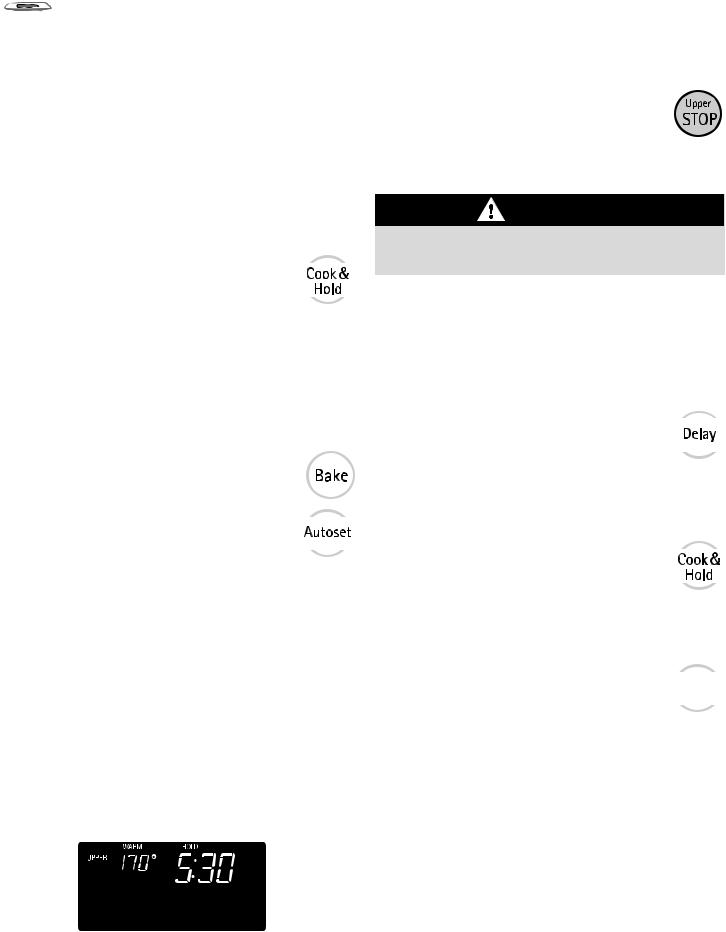
 Oven Cooking
Oven Cooking
The oven light will remain on until the Oven Light pad is pressed.
• Press any pad to recall the cook time remaining.
7.When cooking is finished, press Lower STOP pad.
8.Remove food from the oven.
Cook & Hold
When using the Cook & Hold feature, the oven begins to heat immediately after the control has been set. Then, the oven cooks for a specified length of time. When that time has elapsed, the oven will keep the food warm for up to one hour then automatically turn off.
To set Cook & Hold:
1. Press the Cook & Hold pad once for upper oven or twice for lower oven.
HOLD will flash to indicate that you are in
Cook & Hold programming.
00:00 and either UPPER or LOWER will flash in the display.
2.Select the amount of time you want to cook by using the number pads.
HOLD continues to flash.
The time will light in the display.
• Time can be set from 00:10 to 11:59.
3. Press Bake (upper and lower ovens), Convect Bake or Convect Roast (lower oven only) and select the oven temperature. Press the Autoset pad for 350 F or the appropriate number pads.
•The desired function, 000 and either UPPER or LOWER will flash.
The oven temperature can be set from 170 F to 550 F.
4.Press the desired function pad again OR wait four (4) seconds.
The desired function will remain lit.
The cooking time will show in the display.
PREHEAT will show in the display.
The actual oven temperature will be displayed during preheat.
The set temperature will display when the oven is preheated.
When the cooking time has elapsed:
Four beeps will sound.
WARM and HOLD will light.
170 appears in the display.
After one hour in WARM HOLD:
•The oven turns off automatically.
•Press STOP pad and remove food from the oven.
To cancel Cook & Hold at any time:
Press the appropriate STOP pad. Remove food from oven.
Delay Cook & Hold
CAUTION
Do not use delayed baking for highly perishable foods such as dairy products, pork, poultry, or seafood.
When using Delay, the oven begins to cook later in the day. Set the amount of time that you want to delay before the oven turns on and how long you want to cook. The oven begins to heat at the selected time and cooks for the specified length of time, then keeps food warm for one hour.
Delay time can be set from 10 minutes (00:10) to 11 hours, 59 minutes (11:59).
To set a Delayed Cook & Hold cycle:
1.Press the Delay pad once to program the upper oven or twice to program the lower oven.
DELAY flashes in the display.
00:00 and either UPPER or LOWER flash in the display.
2.Using the appropriate number pads, enter the amount of time you want to delay the start of the Cook & Hold cycle.
3.Press the Cook & Hold pad.
HOLD and DELAY flash in the display.
00:00 and either UPPER or LOWER flash.
4.Enter the amount of time you want to cook using the number pads.
5.Press Bake (upper and lower ovens), Convect Bake or Convect Roast (lower oven only).
6. Set the oven temperature desired by pressing  the Autoset pad or the appropriate number pads.
the Autoset pad or the appropriate number pads.
•350 will light when Autoset is pressed.
•After four seconds, the entered delay time will appear in the display.
•BAKE and DELAY remain lit to remind you that
a delayed Cook & Hold function has been programmed.
Important:
Do not use Delayed Cook & Hold for items that require a preheated oven, such as cakes, cookies, and breads.
Do not use Delayed Cook & Hold if oven is already hot.
14
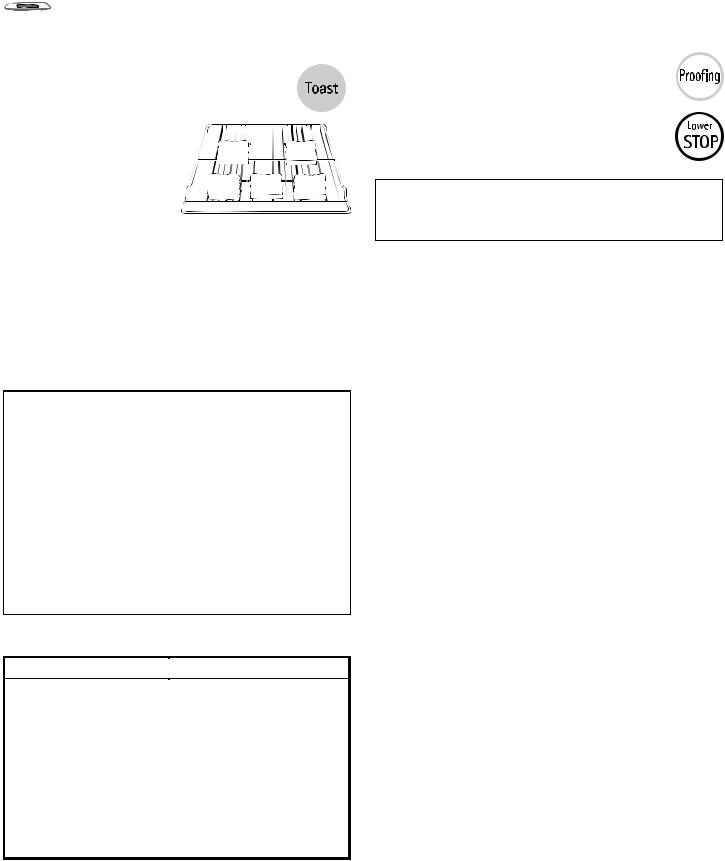
 Oven Cooking
Oven Cooking
Toasting (upper oven only)
For toasting bread and products that are toasted in a toaster or toaster oven.
1.Press the Toast pad.
2.Press the Autoset pad to set
minutes of toasting time. Each
additional press will increase the toasting time by 1
minute. TOAST and the UPPER will be displayed.
The toasting time will begin to count down.
Or, press the appropriate number pads to set the toasting time in minutes and seconds between 10 seconds and 6 minutes.
Example: To set toasting time for two minutes, press 2 0 0
Browning time may vary; watch toasting carefully to avoid over-browning. Close oven door during toasting.
3.At the end of the set toasting time, the oven will beep four times.
Notes:
Lower oven may not be operated while upper oven is toasting. If the lower oven is operating when the Toast pad is pressed, a beep will sound.
Toasting is based on time, not temperature.
For more even browning results, preheat the oven 3-4 minutes.
Toasting times will be shorter when the oven is hot or when repeated toasting functions are done.
For optimal results when toasting 4-5 pieces of bread or other similar items, follow illustration above.
Toasting Chart
|
FOOD |
|
TOAST TIME*/COLD START |
|
|
|
|
|
|||
|
|
|
|
|
|
Sliced White Bread |
|
3 /2 - 4 /2 min. |
|||
|
|||||
Waffles (frozen) |
|
4 - 4 /2 min. |
|||
|
|||||
Toaster Pastry (unfrozen) |
|
3 /2 |
- 4 min. |
||
|
|||||
Toaster Pastry (frozen) |
|
4 /2 - 43/4 min |
|||
|
|||||
Tortillas (flour) |
|
2 /2 |
- 3 min. |
||
|
|||||
Toaster Breaks** or |
|
4 - 5 min. |
|||
|
|||||
Hot Pockets** |
|
|
|
|
|
Bagels |
|
4 /2 |
- 5 min. |
||
|
|||||
English Muffins |
|
3 /2 |
- 4 min. |
||
|
|||||
Cheese Sandwich |
|
3 /2 - 4 /2 min |
|||
|
|||||
*Toasting times are approximate and should be used as a guide only.
**Brand names are registered trademarks of the respective manufacturers.
Proofing ( lower oven only)
The Proofing feature can be used to raise yeast-based bread products prior to baking.
1. Press Proofing pad.
2. When proofing is complete, remove the dough from the oven and press the Lower STOP pad.
Note: If oven temperature is too high for proofing, OVEN COOLING will appear in the display.
15
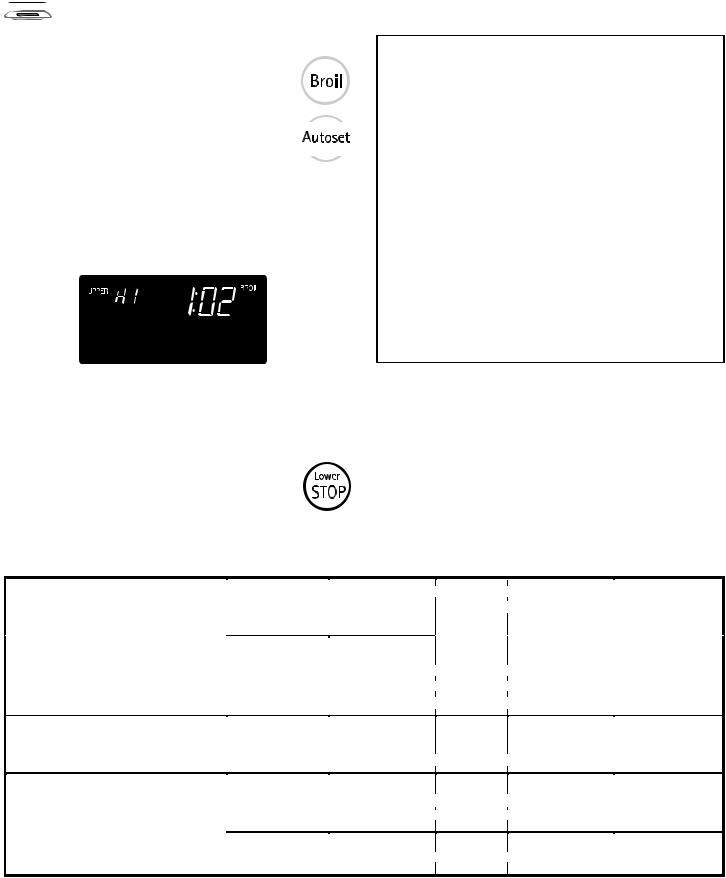
 Oven Cooking
Oven Cooking
Broiling
To set Broil:
1. Press the appropriate Broil pad.
BROIL, UPPER and SET flash.
2.Press the Autoset pad once to set HI broil or twice to set LO broil.
HI or LO will be displayed.
Select HI broil for normal broiling. Select LO broil for low-temperature broiling of longer cooking foods such as poultry.
3. After four seconds, the oven will start.
BROIL and HI or LO will remain lit.
4.For optimum browning, preheat broil element for 3-4 minutes before adding food.
5.Place food in the oven. Leave oven door open about four inches (the first stop).
6.Turn meat once while cooking.
7. When food is cooked, press the appropriate STOP pad. Remove food and broiler pan from the oven.
Notes:
For best results when broiling, use a two-piece broiler pan.
HI broil is used for most broiling. Use LO broil when broiling longer cooking foods to allow them to cook to well done stage without excessive browning.
Broil times may be longer when the lower broiling temperature is selected.
Never cover broiler pan insert with aluminum foil. This prevents fat from draining to the pan below.
Expect broil times to increase and browning to be slightly lighter if appliance is installed on a 208-volt circuit.
If more than 30 seconds elapse between pressing the Broil pad and the Autoset pad, the oven will not be set and the display will return to the previous display.
Most foods should be turned halfway through broiling time.
Broiling Chart - Broil times are based on a 4 minute preheat.
|
|
|
|
|
UPPER OVEN |
|
|
|
LOWER OVEN |
|
|
|
UPPER OVEN |
|
LOWER OVEN |
|
|
|||||
|
|
|
|
|
|
|
|
|
|
|
|
|
|
|||||||||
|
FOODS |
|
|
|
|
RACK |
|
|
|
|
RACK |
|
|
SETTING |
|
|
COOK TIME |
|
|
COOK TIME |
|
|
|
|
|
|
|
|
|
|
|
||||||||||||||
|
|
|
|
|
|
POSITION* |
|
|
|
POSITION* |
|
|
|
|
(MINUTES)** |
|
(MINUTES)** |
|
|
|||
|
|
|
|
|
|
|
|
|
|
|
|
|
|
|
|
|
|
|
|
|
|
|
Beef |
|
|
|
|
|
|
|
|
|
|
|
|
|
|
|
|
|
|
|
|
|
|
Steak, 1 |
thick, |
|
|
|
|
on rack |
|
4 |
|
|
HI |
|
|
8 - 11 (medium) |
|
15 - 19 (medium) |
||||||
|
|
|
|
|
|
|
|
|
|
|||||||||||||
4 oz. Hamburgers, 3/4 |
thick (up to 12) |
|
|
|
on rack |
|
4 |
|
|
HI |
|
|
15 - 20 (well) |
|
|
15 - 19 (well) |
||||||
|
|
|
|
|
|
|
|
|
||||||||||||||
4 oz. Hamburgers, 3/4 |
thick (up to 6) |
|
|
|
on rack |
|
4 |
|
|
HI |
|
|
12 - 16 (well) |
|
|
15 - 19 (well) |
||||||
|
|
|
|
|
|
|
|
|
||||||||||||||
Chicken |
|
|
|
|
|
|
|
|
|
|
|
|
|
|
|
|
|
|
|
|
|
|
Bone-in, skin-on breast |
|
|
|
|
|
|
|
|
|
|
|
|
|
|
|
|
|
|
||||
Pieces |
|
|
|
|
|
on rack |
|
|
|
3 or 4 |
|
LO |
|
|
25 - 36 (well) |
|
|
28 - 39 (well) |
||||
|
|
|
|
|
|
|
|
|
|
|
|
|
||||||||||
Fish |
|
|
|
|
|
|
|
|
|
|
|
|
|
|
|
|
|
|
|
|
|
|
Filets |
|
|
|
|
|
on rack |
|
4 |
|
|
LO |
|
|
8 - 12 (flaky) |
|
|
8 - 13 (flaky) |
|||||
|
|
|
|
|
|
|
|
|
|
|
|
|||||||||||
Steaks, 1 |
thick |
|
|
|
|
on rack |
|
4 |
|
|
LO |
|
|
10 - 14 (flaky) |
|
|
10 - 16 (flaky) |
|||||
|
|
|
|
|
|
|
|
|
|
|
||||||||||||
|
|
|
|
|
|
|
|
|
|
|
|
|
|
|
|
|
|
|
|
|
|
|
Pork |
|
|
|
|
|
|
|
|
|
|
|
|
|
|
|
|
|
|
|
|
|
|
Chops, 1 |
thick |
|
|
|
|
on rack |
|
4 |
|
|
HI |
|
|
18 - 24 (well) |
|
|
22 - 27 (well) |
|||||
|
|
|
|
|
|
|
|
|
|
|
||||||||||||
|
|
|
|
|
|
|
|
|
|
|
|
|
|
|
|
|
|
|
|
|
|
|
* When broiling fish, spray broil pan insert with cooking oil. Do not turn fish filets.
** Broiling times are approximate and may vary depending on the thickness of the food. Turn meat halfway through cooking times.
16

 Oven Cooking
Oven Cooking
Keep Warm
For safely keeping hot foods warm or for warming breads and plates.
To set Keep Warm:
1. Press the appropriate Keep Warm pad.
WARM flashes.
000 and either UPPER or LOWER flash in the display.
2.Select the Keep Warm temperature. Press the Autoset pad or the appropriate number pads.
170 will light when the Autoset pad is pressed.
Each press of the Autoset pad will increase the temperature by 5
The Keep Warm temperature can be set from 145 to 190
WARM and the temperature will be displayed while the function is active.
To cancel Keep Warm:
1. Press the appropriate STOP pad.
2. Remove food from the oven.
Notes:
•For optimal food quality, oven cooked foods should be kept warm for no longer than 1 to 2 hours.
•To keep foods from drying, cover loosely with foil or a lid.
•To warm dinner rolls:
-cover rolls loosely with foil and place in oven.
-press Keep Warm and Autoset pads.
-warm for 12-15 minutes.
To warm plates:
-place 2 stacks of up to four plates each in the oven.
-press Keep Warm and Autoset pads.
-warm for 5 minutes, turn off the oven and leave plates in the oven for 15 minutes more.
-use only oven-safe plates, check with the manufacturer.
do not set warm dishes on a cold surface as rapid temperature changes could cause crazing or breakage.
Favorite
The Favorite pad allows you to save the time and temperature from a Cook & Hold Bake, Cook & Hold Convect Bake or Cook & Hold Convect Roast (lower oven only) operation.
To set a Favorite setting, a Cook & Hold function must be either active or just programmed.
To set a new Favorite operation or to save a currently running Cook & Hold as a Favorite:
1.Program a Cook & Hold setting as described in the
Cook & Hold section on page 14.
2. Press and hold the Favorite pad for three (3) seconds.
The newly set or currently running Cook & Hold setting will be saved.
A double then a single beep will sound to indicate that the control has accepted the Favorite setting.
To start a cycle programmed into Favorite:
1. Press the Favorite pad.
Time and temperature for the set Cook & Hold setting will be displayed. (If no Cook & Hold setting has been programmed, nonE is displayed.)
2.Press the Bake Convect Bake or Convect Roast (lower oven only) pad.
The Favorite setting will begin immediately.
The selected function will light in the display
The cooking time will light in the display
When the cooking time has elapsed:
The selected function will turn off.
WARM HOLD will light.
170 will display.
To cancel a Favorite setting in progress:
1. Press the STOP pad.
2. Remove food from the oven.
The stored Favorite setting will not be affected.
17
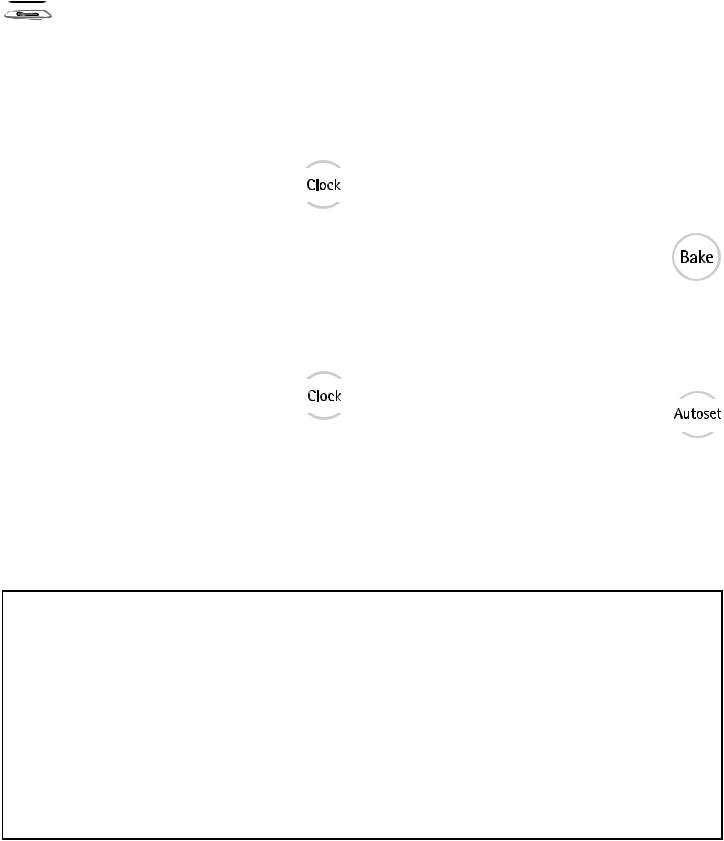
 Oven Cooking
Oven Cooking
Automatic Shut-Off/Sabbath Mode
The ovens will automatically turn off after 12 hours if you accidentally leave them on.
To cancel the 12-hour shut-off and run an oven continuously for 72 hours:
1. Press and hold the Clock pad for three
(3) seconds
• “SAb will be displayed and flash for five seconds.
•“SAb will then be displayed continuously until turned off or until the 72-hour time limit is reached.
BAKE will also be displayed if a bake setting is in use while the oven is in Sabbath Mode.
All pads are inactive except STOP and Clock. All other functions EXCEPT BAKE (Timer, Keep Warm, Clean, etc.) are locked out during the Sabbath Mode.
To cancel the Sabbath Mode:
1. Press the Clock pad for three (3) seconds.
•“SAb will flash for five seconds.
The time of day will return to the display.
OR
2.After 72 hours, the Sabbath Mode will end.
•“SAb will flash for five seconds.
The time of day will return to the display.
Notes:
Sabbath Mode can be turned on at any time with or without the ovens on.
Sabbath Mode cannot be turned on if the keypads are locked out or when the doors are locked.
Most prompts and messages and all beeps are deactivated when Sabbath Mode is active.
If an oven is baking when Sabbath Mode is set, BAKE will go out at the end of the baking cycle or when the STOP pad is pressed. There will be no audible beeps.
If the oven lights are desired while in Sabbath Mode, they must be turned on before the Sabbath Mode is started.
Adjusting the Oven Temperature
Oven temperatures are carefully tested for accuracy at the factory. It is normal to notice some baking or browning differences between a new oven and an old one. As ovens get older, the oven temperature can shift.
You may adjust the oven temperature if you think the oven is not baking or browning correctly. To decide how much to change the temperature, set the temperature 25 degrees higher or lower than your recipe recommends, then bake. The results of the first bake should give you an idea of how much to adjust the temperature.
To adjust the oven temperature:
1.Press the appropriate Bake pad.
2.Enter 550 by pressing the appropriate number pads.
3.Press and hold the Bake pad for several seconds or until 00 appears in the display.
If the oven temperature was previously adjusted, the change will be displayed. For example, if the oven temperature was reduced by 15 the display will show -15°
4. Press the Autoset pad to adjust the temperature.
Each time the Autoset pad is pressed, the temperature changes by 5 . The oven temperature can be increased or decreased by 5 to 35
5. The time of day will automatically reappear in the display.
You do not need to readjust the oven temperature if there is a power failure or interruption. Temperature adjustment applies to Bake, Convect Bake and Convect Roast (lower oven only) only.
When the Sabbath Mode is started, the temperature display will immediately show the set temperature, rather than the actual oven cavity temperature. No preheat beep will sound.
The self-clean cycle and automatic door lock do not operate during the Sabbath Mode.
Pressing STOP pad will cancel a Bake cycle, however the control will stay in the Sabbath Mode.
•If power fails, the ovens will power up in Sabbath Mode with 72 hours remaining and no cycle active.
18
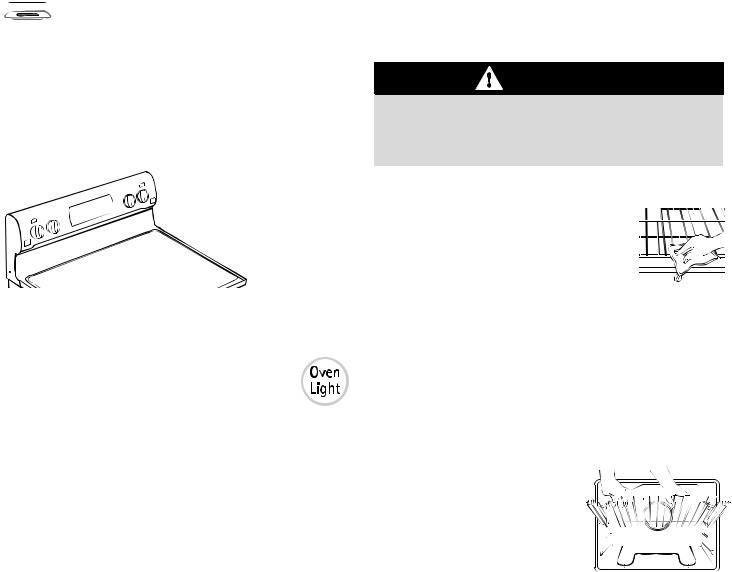
 Oven Cooking
Oven Cooking
Oven Vent
When the oven is in use the area near the vent may become hot enough to cause burns. Never block the vent opening.
The oven vent is located below the backguard on your range.
When high moisture foods are cooked in the upper oven, steam may be visible coming from the oven vent. This is n
Do not place plastics near the vent opening as heat from the vent could distort or melt the plastic.
Oven Lights
The oven lights automatically come on whenever an oven door is opened. When the door is closed, press the Oven Light pad to turn the oven light on or off.
A beep will sound every time the Oven Light pad is pressed.
Oven Bottom
Protect oven bottom against spillovers, especially acidic or sugary spills, as they may discolor the porcelain enamel. Use the correct pan size to avoid spillovers and boilovers. Do not place utensils or aluminum foil directly on the oven bottom.
Oven Racks
CAUTION
•Do not attempt to change the rack position when the oven is hot.
Do not use the oven for storing food or cookware.
All racks are designed with a lock-stop edge.
Upper oven
Is equipped with one rack and rack position.
When pulling the upper oven rack out to remove or check food, grasp the top edge of the rack.
Lower oven
Is equipped with one glide rack, one regular flat rack and one half-rack.
To remove oven racks:
Pull rack straight out until it stops at the lock-stop position; lift up on the front of the rack and pull out.
For glide rack, pull both the rack glide and rack base out together.
To replace oven racks:
Place rack on the rack support in 




 the oven; tilt the front end up
the oven; tilt the front end up  slightly; slide rack back until it
slightly; slide rack back until it 


 clears the lock-stop position; lower
clears the lock-stop position; lower 



 front and slide back into the oven.
front and slide back into the oven.
Oven Fan
A convection fan is used to circulate hot air in the oven when the convection feature is selected. It automatically turns on after the Convect Bake or Convect Roast pads are pressed and will turn off when convection is canceled.
Important: The convection fans will automatically stop when the oven door is opened.
Baking and Roasting with the
Glide Rack (lower oven only)
Baking
For optimal baking results when baking on one rack, use the glide rack.
When baking on two racks, use the glide rack in the bottom rack position, and the flat rack in the upper rack position.
Roasting
When roasting large cuts of meat and poultry, use the glide rack for ease of movement.
19
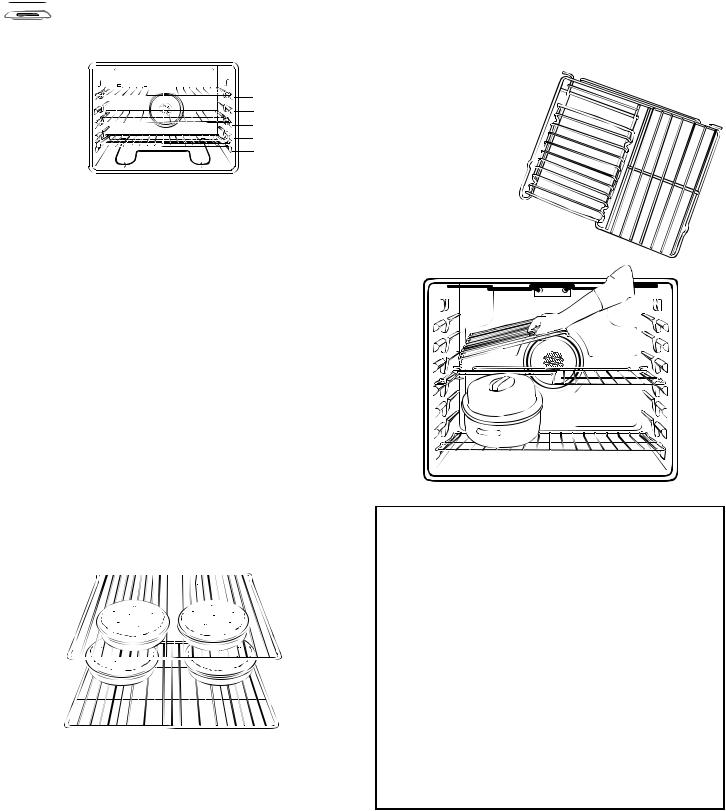
 Oven Cooking
Oven Cooking
Rack Positions (lower oven)
5
4
3
2
RACK 5 : Use for toasting bread or broiling very thin foods and two-rack baking.
RACK 4: Use for two-rack baking and for broiling.
RACK 3: Use for most baked goods on a cookie sheet or jelly roll pan, layer cakes, fruit pies, or frozen convenience foods and for broiling.
RACK 2: Use for roasting small cuts of meat, casseroles, baking loaves of bread, bundt cakes or custard pies and two-rack baking.
RACK 1: Use for roasting large cuts of meat and poultry, frozen pies, dessert souffles or angel food cake and two-rack baking.
MULTIPLE RACK COOKING:
Two rack: Use rack positions 2 and 4, 1 and 4 or 2 and 5.
Three rack: Use rack positions 1, 3 and 5. See illustration above.
Baking Layer Cakes on Two Racks
For best results when baking cakes on two racks, use racks 2 and 4.
Place the cakes on the rack as shown.
Half Rack
Select range models are equipped with a convertibl half rack. The left side of the rack can be removed to accommodate a large roaster on the lower
rack. The right side of the rack is still available to hold a casserole dish.
Notes:
The removable section of the rack can be used as a roasting rack in a broiling pan. Do not use the top insert when using the rack in a broiling pan.
The removable section of the rack can be used as a cooling rack or trivet.
Make sure oven is cool before removing or reinstalling the half rack.
Do not use cookware that extends beyond edge of rack.
For best results, allow two inches between the pan placed on the rack and the oven side wall.
Use caution when removing items from the half rack to avoid burns.
Carefully remove items from the lower rack to avoid disturbing the half rack.
20
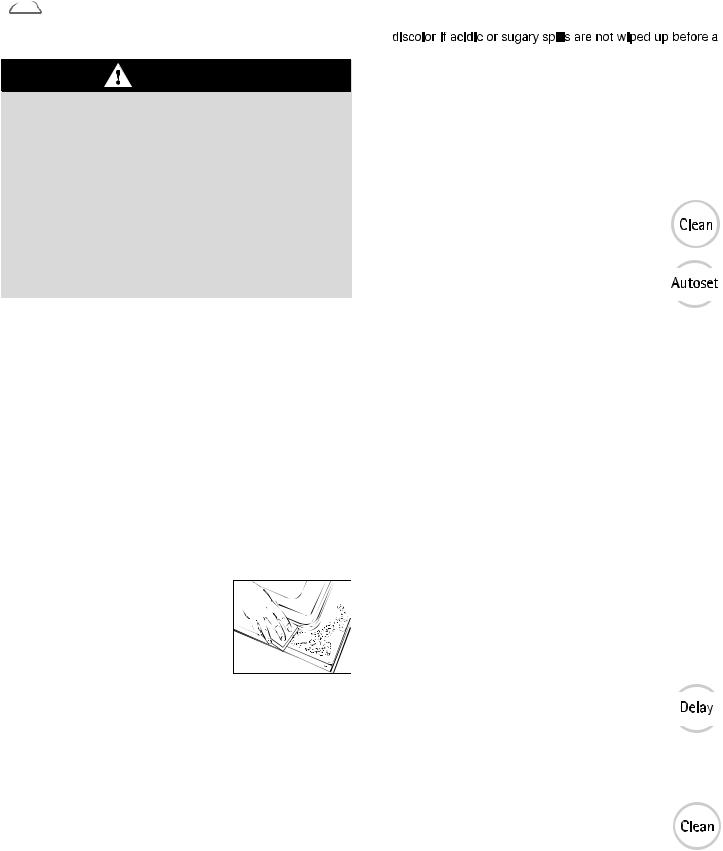
 Care & Cleaning
Care & Cleaning
Self-Clean Ovens
CAUTION
•It is normal for parts of the oven to become hot during a self-clean cycle.
•To prevent damage to oven doors, do not attempt to open the doors when LOCK is displayed.
Avoid touching door, window or oven vent area during a clean cycle.
Do not use commercial oven cleaners on the oven finish or around any part of the oven. They will damage the finish or parts.
DO NOT leave baking/pizza stone in oven during self clean.
The self-clean cycle uses above-normal cooking temperatures to automatically clean the oven interior.
It is normal for flare-ups, smoking, or flaming to occur during cleaning if the oven is heavily soiled. It is better to clean the oven regularly rather than to wait until there is a heavy buildup of soil in the oven.
During the cleaning process, the kitchen should be well ventilated to get rid of normal odors associated with cleaning.
Before Self-Cleaning
1.Turn off the oven light before cleaning as the light may burn out during the clean cycle.
2.Remove broiler pan, all pans, and oven racks from the oven. The oven racks will discolor and may not slide easily after a self-clean cycle if they are not removed.
3.Clean oven frame, door frame (area outside of gasket, and around the
opening in the door gasket) with a
nonabrasive cleaner such as Bon Ami* or detergent and water. The self-cleaning process does not
clean these areas. They should be
cleaned to prevent soil from baking on during the clean cycle. (The gasket is the seal around the oven door and window.)
4.To prevent damage, do not clean or rub the gasket around the oven door. The gasket is designed to seal in heat during the clean cycle.
5.Wipe up excess grease or spillovers from the oven bottom.
This prevents excessive smoking, flare-ups or flaming during the clean cycle.
6.Wipe up sugary and acidic spillovers such as sweet potatoes, tomato, or milk-based sauces. Porcelain enamel is acid-resistant, not acid-proof. The porcelain finish may
self-clean cycle.
Important:
Oven temperature must be below 400° F to program a clean cycle.
Only one oven can be cleaned at a time.
Both oven doors lock when either oven is being cleaned.
To set Self-Clean:
1. Close the oven door.
2. Press the Clean pad.
CLEAN flashes.
SET and UPPER or LOWER flash in the display.
3.Press the Autoset pad.
• “ MEd (Medium Soil, 3 hours) is displayed.
4.Press the Autoset pad to scroll through the self-cleaning settings.
HVy (Heavy Soil, 4 hours)
MEd (Medium soil, 3 hours)
LITE ( Light Soil, 2 hours)
Choosing the soil level of the oven automatically programs the self-cleaning time.
5.After four seconds, the oven will start cleaning.
•If the door is not closed, beeps will sound and door will display. If the door is not closed within 30 seconds, the self-cleaning operation will be canceled and the display will return to the time of day.
•CLEAN will appear in the display.
•LOCK will flash in the display. Once the door locks, LOCK will remain steady.
The cleaning time will start counting down in the display.
To Delay a Self-Clean Cycle:
1.Press the Delay pad once for upper oven and twice for lower oven.
DELAY flashes.
00:00 and UPPER or LOWER will flash in the display.
2.Enter the amount of time you want to delay the cycle using the appropriate number pads.
3.Press the appropriate Clean pad.
SET flashes in the display.
* Brand names for cleaning products are registered trademarks of the respective manufacturers.
21
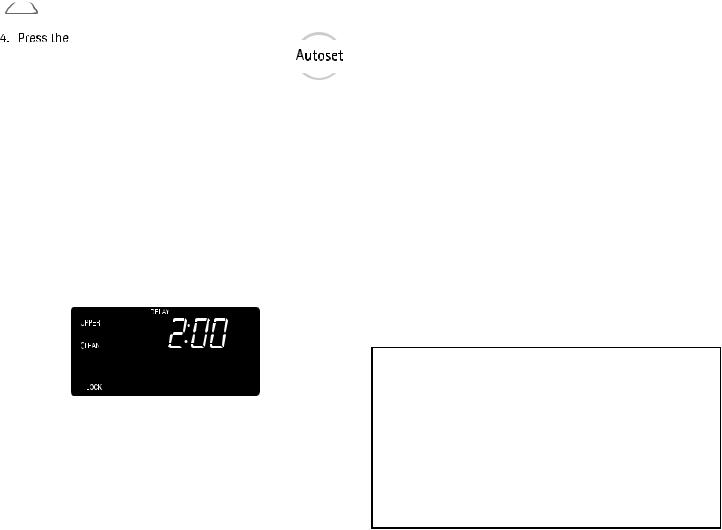
 Care & Cleaning
Care & Cleaning
Autoset pad.
• “LITE (Light soil level) is displayed.
5.Press the Autoset pad to scroll through the self-cleaning settings.
HVy (Heavy Soil, 4 hours)
MEd (Medium Soil, 3 hours)
LITE (Light Soil, 2 hours)
Choosing the soil level of the oven automatically programs the self-cleaning time.
6.After four seconds, CLEAN, DELAY and UPPER or LOWER will light and LOCK will flash in the display. When the oven door latches, LOCK will stop flashing and light continuously to show that the oven is set for a delayed clean operation. The delay time will display.
During the Self-Clean Cycle
When LOCK shows in the display, both oven doors are locked. To prevent damage to the doors, do not force the doors open when LOCK is displayed.
Smoke and Smells
You may see some smoke and smell an odor the first few times the oven is cleaned. This is normal and will lessen in time.
Smoke may also occur if the oven is heavily soiled or if a broiler pan was left in the oven.
Sounds
As the oven heats, you may hear sounds of metal parts expanding and contracting. This is normal and will not damage the oven.
After Self-Cleaning
About one hour after the end of the self-clean cycle, LOCK will turn off. The doors can then be opened.
Some soil may leave a light gray, powdery ash. Remove it with a damp cloth. If soil remains after wiping, that means the clean cycle was not long enough. The soil will be removed during the next clean cycle.
If oven racks were left in the oven and do not slide smoothly after a clean cycle, wipe racks and rack supports with a small amount of vegetable oil to make them easier to move.
Fine lines may appear in the porcelain because it went through heating and cooling . This is normal and will not affect performance.
A white discoloration may appear after cleaning if acidic or sugary foods were not wiped up before the self-clean cycle . This discoloration is normal and will not affect performance.
Notes:
If an oven door is left open, door will appear in the display and a signal will beep until the door is closed and the Clean pad is pressed again.
If more than 30 seconds elapse between pressing the Clean pad and the Autoset pad, the program will automatically return to the previous display.
The oven doors will be damaged if the oven doors are forced to open when LOCK is still displayed.
22

 Care & Cleaning
Care & Cleaning
Cleaning Procedures
CAUTION
Be sure appliance is off and all parts are cool before handling or cleaning. This is to avoid damage and possible burns.
To prevent staining or discoloration, clean appliance after each use.
If a part is removed, be sure it is correctly replaced.
*Brand names are registered trademarks of the respective manufacturers.
**To order call 1-800-FOR-MY HOME® or 1-800-469-4663 USA and Canada.
PART |
PROCEDURE |
|
|
Backguard and Porcelain enamel is glass fused on metal and may crack or chip with misuse. It is acid-resistant, not acid-
Cooktop – |
proof. All spillovers, especially acidic or sugary spillovers, should be wiped up immediately with a dry cloth. |
Porcelain |
When cool, wash with soapy water, rinse and dry. |
Enamel |
Never wipe off a warm or hot surface with a damp cloth. This may cause cracking or chipping. |
|
Never use oven cleaners, abrasive or caustic cleaning agents on exterior finish of range. |
Broiler Pan |
Never cover insert with aluminum foil as this prevents the fat from draining to the pan below. |
and Insert |
Place soapy cloth over insert and pan; let soak to loosen soil. |
|
Wash in warm soapy water. Use scouring pad to remove stubborn soil. |
|
Broiler pan and insert can be cleaned in dishwasher. |
Clock and |
To activate Control Lock for cleaning, see page 11. |
Control Pad |
Wipe with a damp cloth and dry. Do not use abrasive cleaning agents as they may scratch the surface. |
Area |
Glass cleaners may be used if sprayed on a cloth first. DO NOT spray directly on control pad and |
|
display area. |
Control Knobs |
Remove knobs in the OFF position by pulling forward. |
|
Wash, rinse and dry. Do not use abrasive cleaning agents as they may scratch the finish. |
|
Turn on each element to be sure the knobs have been correctly replaced. |
Cooktop – |
Never use oven cleaners, chlorine bleach, ammonia or glass cleaners with ammonia. Important: |
Glass-Ceramic Call an authorized servicer if the glass-ceramic top should crack, break or if metal or aluminum foil should melt on the cooktop.
Allow the cooktop to cool before cleaning.
General – Clean cooktop after each use, or when needed, with a damp paper towel and Cooktop Cleaning Creme* (Part No. 20000001)**. Then, buff with a clean dry cloth.
Important: Permanent stains will develop if soil is allowed to cook on by repeatedly using the cooktop when soiled.
Heavy Soils or Metal Marks Dampen a scratchless or never scratch scrubber sponge. Apply Cooktop Cleaning Creme* (Part No. 20000001)** and scrub to remove as much soil as possible. Apply a thin layer of the creme over the soil, cover with a damp paper towel and let stand 30 to 45 minutes (2-3 hours for very heavy soil). Keep moist by covering the paper towel with plastic wrap. Scrub again, then buff with a clean, dry cloth.
Important: Only use a CLEAN, DAMP “scratchless” pad that is safe for non-stick cookware. The pattern and glass will be damaged if the pad is not damp, if the pad is soiled, or if another type of pad is used.
Burned-on or Crusty Soils Scrub with a scratchless or never scratch scouring pad and Cooktop Cleaning Creme*.
Important: Hold a razor blade scraper at 30 angle and scrape any remaining soil. Then, clean as described above. Do not use the razor blade for daily cleaning as it may wear the pattern on the glass.
Melted Sugar or Plastic Immediately turn element to LO and scrape sugar or plastic from hot surface to a cool area. Then turn element OFF and allow to cool. Clean
residue with razor blade scraper and Cooktop Cleaning Creme*.
23
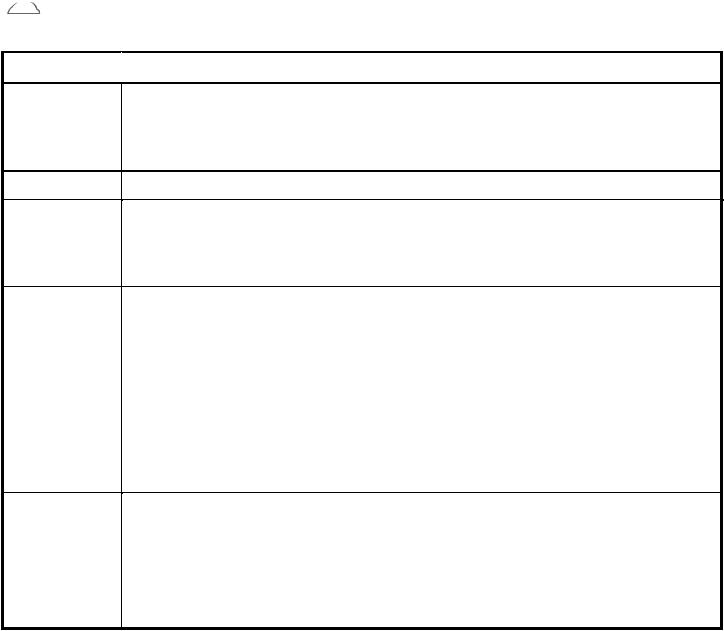
 Care & Cleaning
Care & Cleaning
PART |
PROCEDURE |
|
|
|
|
Oven Windows |
Avoid using excessive amounts of water which may seep under or behind glass, causing staining. |
|
and Doors – |
Wash with soap and water. Rinse with clear water and dry. Glass cleaner can be used if sprayed on a |
|
Glass |
cloth first. |
|
|
Do not use abrasive materials such as scouring pads, steel wool or powdered cleaners as they will |
|
|
scratch glass. |
|
Oven Interiors |
Follow instructions on pages 21-22 to set a self-clean cycle. |
|
Oven Racks |
Clean with soapy water. |
|
|
Remove stubborn soil with cleansing powder or soap-filled scouring pad. Rinse and dry. |
|
|
Racks will permanently discolor and may not slide smoothly if left in the oven during a self-clean operation. |
|
|
If this occurs, wipe the rack edge and rack support with a small amount of vegetable oil to restore ease |
|
|
of movement, then wipe off excess oil. |
|
Stainless Steel |
DO NOT USE ANY CLEANING PRODUCT CONTAINING CHLORINE BLEACH. |
|
(select models) |
DO NOT USE ABRASIVE OR ORANGE CLEANERS. |
|
|
ALWAYS WIPE WITH THE GRAIN WHEN CLEANING. |
|
|
Daily Cleaning/Light Soil –– Wipe with one of the following - soapy water, white vinegar/water solution, |
|
|
Formula 409 Glass and Surface Cleaner* or a similar glass cleaner - using a sponge or soft cloth. Rinse |
|
|
and dry. To polish and help prevent fingerprints, follow with Stainless Steel Magic Spray (Part No. |
|
|
20000008)**. |
|
|
Moderate/Heavy Soil –– Wipe with one of the following - Bon Ami, Smart Cleanser, or Soft Scrub* - |
|
|
using a damp sponge or soft cloth. Rinse and dry. Stubborn soils may be removed with a damp multi- |
|
|
purpose Scotch-Brite* pad; rub evenly with the grain. Rinse and dry. To restore luster and remove streaks, |
|
|
follow with Stainless Steel Magic Spray*. |
|
|
Discoloration –– Using a damp sponge or soft cloth, wipe with Cameo Stainless Steel Cleaner*. Rinse |
|
|
immediately and dry. To remove streaks and restore luster, follow with Stainless Steel Magic Spray*. |
|
Door Handle, |
When cool, wash with warm soapy water, rinse and dry. Never wipe a warm or hot surface with a damp |
|
Side Panels – |
cloth as this may damage the surface and may cause a steam burn. |
|
Painted Enamel |
For stubborn soil, use mildly abrasive cleaning agents such as baking soda paste or Bon Ami.* Do not use |
|
|
abrasive, caustic or harsh cleaning agents such as steel wool pads or oven cleaners. These products will |
|
|
scratch or permanently damage the surface. |
|
|
Important: Use a dry towel or cloth to wipe up spills, especially acidic or sugary spills. Surface |
|
|
may discolor or dull if soil is not immediately removed. This is especially important for |
|
|
white surfaces. |
|
|
|
|
|
|
|
** To order direct, call 1-800-FOR-MY HOME® or 1-800-469-4663 USA and Canada.
24

 Maintenance
Maintenance
Oven Doors
CAUTION
Do not place excessive weight on or stand on open oven doors. This could cause the range to tip over, break the doors, or injure the user.
Do not attempt to open or close doors or operate oven until doors are properly replaced.
Never place fingers between hinge and front oven frame. Hinge arms are spring mounted. If accidentally hit, the hinge will slam shut against oven frame and could injure your fingers.
Both the upper and lower oven doors are removable.
To remove:
1.When cool, open the oven door to the broil stop position (opened about four inches).
2.Grasp door at each side. Do not use the
door handle to lift door.
3. Lift up evenly until door clears hinge arms.
To replace:
1. Grasp door at each side.
2. Align slots in the door with the hinge arms on the range.
3.Slide the door down onto the hinge arms until the door is completely seated on the hinges. Push down on the top corners of the door to completely seat door on hinges. Door should not appear crooked.
Important: The oven door on a new range may feel spongy when it is closed. This is normal and will decrease
with use.
Oven Windows
To protect the oven door windows:
1.Do not use abrasive cleaning agents such as steel wool scouring pads or powdered cleansers as they may scratch the glass.
2.Do not hit the glass with pots, pans, furniture, toys, or other objects.
3.Do not close an oven door until the oven racks are in place.
Scratching, hitting, jarring or stressing the glass may weaken its structure causing an increased risk of breakage at a later date.
Upper and Lower Oven Lights
CAUTION
Disconnect power to oven before replacing light bulb.
Allow oven to cool before replacing light bulb.
Make sure bulb cover and bulb are cool before touching.
To assure the proper replacement bulb is used, call 1-800-FOR- MY HOME® or 1-800-469-4663 USA and Canada and ask for part number 74009925 - halogen bulb.
To replace oven light bulbs:
1.Disconnect power to the range.
2.When oven is cool, use fingertips to grasp edge of bulb cover. Pull out and remove.
3.Carefully remove old bulb by pulling straight out of ceramic base.
4.To avoid damaging or decreasing the life of the new bulb, do not touch the bulb with bare hands or fingers. Hold with a cloth or paper towel. Push new bulb prongs straight into small holes of ceramic base.
5.Replace bulb cover by snapping into place.
6.Reconnect power to range. Reset clock.
Leveling Legs
CAUTION
Be sure the anti-tip bracket secures one of the rear leveling legs to the floor. This bracket prevents the range from accidentally tipping.
Be sure the range is leveled when installed. If the range is not level, turn the
leveling legs, located at each corner of the range, until range is level.
Convenience Outlet
ANTI- P-TIPBRACKETBRAC ET
LEVELING LEG
LEVELING LEG
(Canadian models only)
The convenience outlet is located on |
|
|
|
the lower left and right sides of the |
|
|
|
backguard. Be sure appliance cords |
|
|
|
do not rest on or near the surface |
|
|
|
cooking area. If the surface cooking |
|
|
|
area is turned on, the cord and outlet |
<![if ! IE]> <![endif]> |
|
|
will be damaged. |
CIRCUIT BREAKE R |
||
|
The convenience outlet circuit breaker may trip if the small appliance plugged into it exceeds 10 amps. To reset the circuit breaker, press the switch located on the bottom of the
25 backguard.

 Troubleshooting
Troubleshooting
PROBLEM |
SOLUTION |
|
|
For most concerns, try these first.
Check if oven controls have been properly set.
Check to be sure plug is securely inserted into receptacle. Check or re-set circuit breaker. Check or replace fuse. Check power supply.
Part or all of appliance does not work.
Check if surface and/or oven controls have been properly set. See pages 7 & 12. Check if oven door is unlocked after self-clean cycle. See page 22.
Check if oven is set for a delayed cook or clean program. See pages 14 & 21. Check if Control Lock is activated. See page 11.
Check if control is in Sabbath Mode. See page 18.
Clock, indicator words, and/or lights operate but oven does not heat.
Oven light and/or clock does not function.
Baking results are not as expected or differ from previous oven.
•Oven may be set for a Cook & Hold or Delay function.
•The Control Lock may have been set. See page 11.
The light bulb is loose or defective.
The oven light does not work during self-cleaning process. Oven may be in Sabbath Mode. See page 18.
Make sure the oven vent has not been blocked. See page 19 for location. Check to make sure range is level.
Temperatures often vary between a new oven and an old one. As ovens age, the oven temperature often drifts and may become hotter or cooler. See page 18 for instructions on adjusting the oven temperature. Important: It is not recommended to adjust the temperature if only one or two recipes are in question.
Food is not broiling properly or smokes excessively.
•Check oven rack positions. Food may be too close to element. Broil element was not preheated.
Aluminum foil was incorrectly used. Never line the broiler insert with foil. Oven door was closed during broiling. Leave the door open to the first stop position (about 4 inches).
Trim excess fat from meat before broiling. A soiled broiler pan was used.
Voltage in house may be low.
Oven will not self-clean.
•Check to make sure the cycle is not set for a delayed start. See page 21.
•Check if door is closed.
Check if control is in Sabbath Mode. See page 18.
Oven may be over 400 F. Oven temperature must be below 400 F to program a clean cycle.
Oven did not clean properly.
Longer cleaning time may be needed.
Excessive spillovers, especially sugary and/or acidic foods, were not removed prior to the self-clean cycle.
Cont.
26
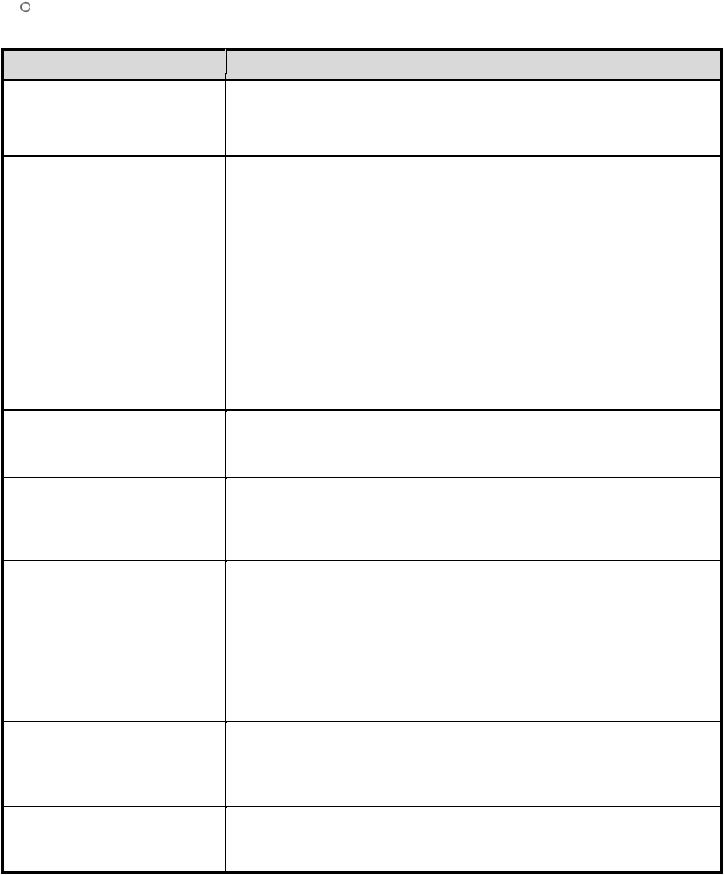
 Troubleshooting
Troubleshooting
PROBLEM
Oven door will not unlock after self-clean cycle.
Smoothtop surface shows wear.
Moisture collects on oven window or steam comes from oven vent.
There is a strong odor or light smoke when oven is turned on.
Fault Codes
Noises may be heard.
There are no beeps and no display.
SOLUTION
Oven interior is still hot. Allow about one hour for the oven to cool after the completion of a self-clean cycle. The door can be opened when LOCK is not displayed.
The control and door may be locked. See page 11.
1.Tiny scratches or abrasions
•Make sure cooktop and pan bottom are clean. Do not slide glass or metal pans across top. Make sure pan bottom is not rough. Use the recommended cleaning agents. See page 23.
2.Metal marks
Do not slide metal pans across top. When cool, clean with Cooktop Cleaning Creme. See page 23.
3. Brown streaks and specks
Remove spills promptly. Never wipe with a soiled cloth or sponge. Make sure cooktop and pan bottom are clean.
4. Areas with a metallic sheen
Mineral deposits from water and food. Use recommended cleaning agents. See page 23.
5. Pitting or flaking
Remove sugary boilovers promptly. See page 23.
This is normal when cooking foods high in moisture.
Excessive moisture was used when cleaning the window.
•This is normal for a new range and will disappear after a few uses. Initiating a clean cycle will burn off the odors more quickly.
Turning on a ventilation fan will help remove the smoke and/or odor. Excessive food soils on the oven bottom. Use a self-clean cycle.
BAKE or LOCK may flash rapidly in the display to alert you if there is an error or a problem. If BAKE or LOCK appear in the display, press STOP pad.
If BAKE or LOCK continue to flash, disconnect power to the appliance.
Wait a few minutes, and then reconnect power. If the flashing still continues, disconnect power to the appliance and call an authorized servicer.
•If the oven is heavily soiled, excessive flareups may result in a fault code during cleaning. Press the STOP pad and allow the oven to cool completely, wipe out excess soil, then reset the clean cycle. If the fault code reappears, contact an authorized servicer.
The oven makes several low level noises. You may hear the oven relays as they go on and off. This is normal.
•As the oven heats and cools, you may hear sounds of metal parts expanding and contracting. This is normal and will not damage your appliance.
Oven may be in Sabbath Mode. See page 18.
27
